Section 1.1 Answers
- The required points [latex]A(-3, -7), \; B(1.3, -2), \; C(\pi, \sqrt{10}), \; D(0, 8), \; E(-5.5, 0), \; F(-8, 4), \; G(9.2, -7.8)[/latex], and [latex]H(7, 5)[/latex] are plotted in the Cartesian Coordinate Plane below.
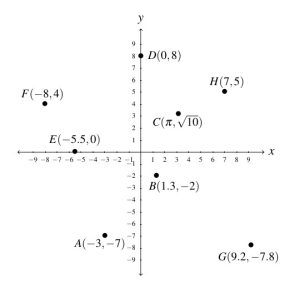
Answer to Exercise 1 - Points
- The point [latex]A(-3, -7)[/latex] is
- in Quadrant III
- symmetric about the [latex]x[/latex]-axis with [latex](-3,7)[/latex]
- symmetric about [latex]y[/latex]-axis with [latex](3, -7)[/latex]
- symmetric about origin with [latex](3, 7)[/latex]
- The point [latex]B(1.3, -2)[/latex] is
- in Quadrant IV
- symmetric about [latex]x[/latex]-axis with [latex](1.3, 2)[/latex]
- symmetric about [latex]y[/latex]-axis with [latex](-1.3, -2)[/latex]
- symmetric about origin with [latex](-1.3, 2)[/latex]
- The point [latex]C(\pi, \sqrt{10})[/latex] is
- in Quadrant I
- symmetric about [latex]x[/latex]-axis with [latex](\pi, -\sqrt{10})[/latex]
- symmetric about [latex]y[/latex]-axis with [latex](-\pi, \sqrt{10})[/latex]
- symmetric about origin with [latex](-\pi, -\sqrt{10})[/latex]
- The point [latex]D(0, 8)[/latex] is
- on the positive [latex]y[/latex]-axis
- symmetric about [latex]x[/latex]-axis with [latex](0, -8)[/latex]
- symmetric about [latex]y[/latex]-axis with [latex](0, 8)[/latex]
- symmetric about origin with [latex](0, -8)[/latex]
- The point [latex]E(-5.5, 0)[/latex] is
- on the negative [latex]x[/latex]-axis
- symmetric about [latex]x[/latex]-axis with [latex](-5.5, 0)[/latex]
- symmetric about [latex]y[/latex]-axis with [latex](5.5, 0)[/latex]
- symmetric about origin with [latex](5.5, 0)[/latex]
- The point [latex]F(-8, 4)[/latex] is
- in Quadrant II
- symmetric about [latex]x[/latex]-axis with [latex](-8, -4)[/latex]
- symmetric about [latex]y[/latex]-axis with [latex](8, 4)[/latex]
- symmetric about origin with [latex](8, -4)[/latex]
- The point [latex]G(9.2, -7.8)[/latex] is
- in Quadrant IV
- symmetric about [latex]x[/latex]-axis with [latex](9.2, 7.8)[/latex]
- symmetric about [latex]y[/latex]-axis with [latex](-9.2, -7.8)[/latex]
- symmetric about origin with [latex](-9.2, 7.8)[/latex]
- The point [latex]H(7, 5)[/latex] is
- in Quadrant I
- symmetric about [latex]x[/latex]-axis with [latex](7, -5)[/latex]
- symmetric about [latex]y[/latex]-axis with [latex](-7, 5)[/latex]
- symmetric about origin with [latex](-7, -5)[/latex]
- The point [latex]A(-3, -7)[/latex] is
- [latex]d = 5[/latex] units, [latex]M = \left(-1, \frac{7}{2} \right)[/latex]
- [latex]d = 4 \sqrt{10}[/latex]units, [latex]M = \left(1, -4 \right)[/latex]
- [latex]d = \sqrt{26}[/latex] units, [latex]M = \left(1, \frac{3}{2} \right)[/latex]
- [latex]d= \frac{\sqrt{37}}{2}[/latex] units, [latex]M = \left(\frac{5}{6}, \frac{7}{4} \right)[/latex]
- [latex]d = \sqrt{74}[/latex] units, [latex]M = \left(\frac{13}{10}, -\frac{13}{10} \right)[/latex]
- [latex]d= 3\sqrt{5}[/latex] units, [latex]M = \left(-\frac{\sqrt{2}}{2}, -\frac{\sqrt{3}}{2} \right)[/latex]
- [latex]d = \sqrt{83}[/latex] units, [latex]M = \left(4 \sqrt{5}, \frac{5 \sqrt{3}}{2} \right)[/latex]
- [latex]d = 2[/latex] units, [latex]M = \left( 0, 0\right)[/latex]
- [latex](-3, -4)[/latex], 5 miles, [latex](4, -4)[/latex]
- The distance from [latex]A[/latex] to [latex]B[/latex] is [latex]|AB| = \sqrt{13},[/latex]the distance from [latex]A[/latex] to [latex]C[/latex] is [latex]|AC| = \sqrt{52},[/latex] and the distance from [latex]B[/latex] to [latex]C[/latex] is [latex]|BC| = \sqrt{65}.[/latex] because [latex]\left(\sqrt{13}\right)^2 + \left( \sqrt{52} \right)^2 = \left( \sqrt{65} \right)^2,[/latex] we are guaranteed by the converse of the Pythagorean Theorem that the triangle is a right triangle.
Section 1.2 Answers
- The mapping [latex]M[/latex] is not a function because “Tennant” is matched with both “Eleven” and “Twelve.”
- The mapping [latex]C[/latex] is a function because each input is matched with only one output. The domain of [latex]C[/latex] is [latex]\{[/latex] Hartnell, Cushing, Hurndall, Troughton [latex]\}[/latex] and the range is [latex]\{[/latex] One, Two [latex]\}[/latex]. We can represent [latex]C[/latex] as the following set of ordered pairs: [latex]\{ (\text{Hartnell}, \text{One}), (\text{Cushing}, \text{One}), (\text{Hurndall}, \text{One}), (\text{Troughton}, \text{Two}) \}[/latex]
- In this case, [latex]y[/latex] is a function of [latex]x[/latex] because each [latex]x[/latex] is matched with only one [latex]y[/latex].The domain is [latex]\{ -3, -2, -1,0,1,2,3 \}[/latex] and the range is [latex]\{ 0,1,2,3 \}[/latex].As ordered pairs, this function is [latex]\{ (-3,3), (-2,2), (-1,1), (0,0), (1,1), (2,2), (3,3) \}[/latex]
- In this case, [latex]y[/latex] is not a function of [latex]x[/latex] because there are [latex]x[/latex] values matched with more than one [latex]y[/latex] value. For instance, 1 is matched both to 1 and [latex]-1[/latex].
- The mapping is a function because given any word, there is only one answer to “how many letters are in the word?” For the range, we would need to know what the length of the longest word is and whether or not we could find words of all the lengths between 1 (the length of the word “a”) and it.
- Because Grover Cleveland was both the 22nd and 24th POTUS, neither mapping described in this exercise is a function.
- The outdoor temperature could never be the same for more than two different times – so, for example, it could always be getting warmer or it could always be getting colder.
- [latex]f(2) = \frac{7}{4}[/latex], [latex]f(x) = \frac{2x+3}{4}[/latex]
- [latex]f(2) = \frac{5}{2}[/latex], [latex]f(x) = \frac{2(x+3)}{4} = \frac{x+3}{2}[/latex]
- [latex]f(2) = 7[/latex], [latex]f(x) = 2\left(\frac{x}{4} + 3\right) = \frac{1}{2} x + 6[/latex]
- [latex]f(2) = \sqrt{7}[/latex], [latex]f(x) = \sqrt{2x+3}[/latex]
- [latex]f(2) = \sqrt{10}[/latex], [latex]f(x) = \sqrt{2(x+3)} = \sqrt{2x+6}[/latex]
- [latex]f(2) = 2 \sqrt{5}[/latex], [latex]f(x) = 2\sqrt{x+3}[/latex]
- For [latex]f(x) = 2x+1[/latex]
- [latex]f(3) = 7[/latex]
- [latex]f(-1) = -1[/latex]
- [latex]f\left(\frac{3}{2} \right) = 4[/latex]
- [latex]f(4x) = 8x+1[/latex]
- [latex]4f(x) = 8x+4[/latex]
- [latex]f(-x) = -2x+1[/latex]
- [latex]f(x-4) = 2x-7[/latex]
- [latex]f(x) - 4 = 2x-3[/latex]
- [latex]f\left(x^2\right) = 2x^2+1[/latex]
- For [latex]f(x) = 3-4x[/latex]
- [latex]f(3) = -9[/latex]
- [latex]f(-1) = 7[/latex]
- [latex]f\left(\frac{3}{2} \right) = -3[/latex]
- [latex]f(4x) = 3-16x[/latex]
- [latex]4f(x) = 12-16x[/latex]
- [latex]f(-x) = 4x+3[/latex]
- [latex]f(x-4) = 19-4x[/latex]
- [latex]f(x) - 4 = -4x-1[/latex]
- [latex]f\left(x^2\right) = 3-4x^2[/latex]
- For [latex]f(x) = 2 - x^2[/latex]
- [latex]f(3) = -7[/latex]
- [latex]f(-1) = 1[/latex]
- [latex]f\left(\frac{3}{2} \right) = -\frac{1}{4}[/latex]
- [latex]f(4x) = 2-16x^2[/latex]
- [latex]4f(x) = 8-4x^2[/latex]
- [latex]f(-x) = 2-x^2[/latex]
- [latex]f(x-4) = -x^2+8x-14[/latex]
- [latex]f(x) - 4 = -x^{2} - 2[/latex]
- For [latex]f(x) = x^2 - 3x + 2[/latex]
- [latex]f(3) = 2[/latex]
- [latex]f(-1) = 6[/latex]
- [latex]f\left(\frac{3}{2} \right) = -\frac{1}{4}[/latex]
- [latex]f(4x) = 16x^2-12x+2[/latex]
- [latex]4f(x) = 4x^2-12x+8[/latex]
- [latex]f(-x) = x^2+3x+2[/latex]
- [latex]f(x-4) = x^2-11x+30[/latex]
- [latex]f(x) - 4 = x^2-3x-2[/latex]
- [latex]f\left(x^2\right) = x^4-3x^2+2[/latex]
- For [latex]f(x) = 6[/latex]
- [latex]f(3) = 6[/latex]
- [latex]f(-1) =6[/latex]
- [latex]f\left(\frac{3}{2} \right) = 6[/latex]
- [latex]f(4x) = 6[/latex]
- [latex]4f(x) = 24[/latex]
- [latex]f(-x) = 6[/latex]
- [latex]f(x-4) = 6[/latex]
- [latex]f(x) - 4 = 2[/latex]
- [latex]f\left(x^2\right) = 6[/latex]
- For [latex]f(x) = 0[/latex]
- [latex]f(3) = 0[/latex]
- [latex]f(-1) =0[/latex]
- [latex]f\left(\frac{3}{2} \right) = 0[/latex]
- [latex]f(4x) = 0[/latex]
- [latex]4f(x) = 0[/latex]
- [latex]f(-x) = 0[/latex]
- [latex]f(x-4) = 0[/latex]
- [latex]f(x) - 4 = -4[/latex]
- [latex]f\left(x^2\right) = 0[/latex]
- For [latex]f(x) = 2x-5[/latex]
- [latex]f(2) = -1[/latex]
- [latex]f(-2) = -9[/latex]
- [latex]f(2a) = 4a-5[/latex]
- [latex]2 f(a) = 4a-10[/latex]
- [latex]f(a+2) = 2a-1[/latex]
- [latex]f(a) + f(2) = 2a-6[/latex]
- [latex]f \left( \frac{2}{a} \right) = \frac{4}{a} - 5 = \frac{4-5a}{a}[/latex]
- [latex]\frac{f(a)}{2} =\frac{2a-5}{2}[/latex]
- [latex]f(a + h) = 2a + 2h - 5[/latex]
- For [latex]f(x) = 5-2x[/latex]
- [latex]f(2) = 1[/latex]
- [latex]f(-2) = 9[/latex]
- [latex]f(2a) = 5-4a[/latex]
- [latex]2 f(a) = 10-4a[/latex]
- [latex]f(a+2) = 1-2a[/latex]
- [latex]f(a) + f(2) = 6-2a[/latex]
- [latex]f \left( \frac{2}{a} \right) = 5 - \frac{4}{a}= \frac{5a-4}{a}[/latex]
- [latex]\frac{f(a)}{2} = \frac{5-2a}{2}[/latex]
- [latex]f(a + h) = 5-2a-2h[/latex]
- For [latex]f(x) = 2x^2-1[/latex]
- [latex]f(2) = 7[/latex]
- [latex]f(-2) = 7[/latex]
- [latex]f(2a) = 8a^2-1[/latex]
- [latex]2 f(a) = 4a^2-2[/latex]
- [latex]f(a+2) = 2a^2+8a+7[/latex]
- [latex]f(a) + f(2) = 2a^2+6[/latex]
- [latex]f \left( \frac{2}{a} \right) = \frac{8}{a^2} - 1= \frac{8-a^2}{a^2}[/latex]
- [latex]\frac{f(a)}{2} = \frac{2a^2-1}{2}[/latex]
- [latex]f(a + h) = 2a^2+4ah+2h^2-1[/latex]
- For [latex]f(x) = 3x^2+3x-2[/latex]
- [latex]f(2) = 16[/latex]
- [latex]f(-2) = 4[/latex]
- [latex]f(2a) = 12a^2+6a-2[/latex]
- [latex]2 f(a) = 6a^2+6a-4[/latex]
- [latex]f(a+2) = 3a^2+15a+16[/latex]
- [latex]f(a) + f(2) = 3a^2+3a+14[/latex]
- [latex]f \left( \frac{2}{a} \right) = \frac{12}{a^2} + \frac{6}{a} - 2 = \frac{12+6a-2a^2}{a^2}[/latex]
- [latex]\frac{f(a)}{2} = \frac{3a^2+3a-2}{2}[/latex]
- [latex]f(a + h) = 3a^2 + 6ah + 3h^2+3a+3h-2[/latex]
- For [latex]f(x) = 117[/latex]
- [latex]f(2) = 117[/latex]
- [latex]f(-2) = 117[/latex]
- [latex]f(2a) = 117[/latex]
- [latex]2 f(a) = 234[/latex]
- [latex]f(a+2) = 117[/latex]
- [latex]f(a) + f(2) = 234[/latex]
- [latex]f \left( \frac{2}{a} \right) = 117[/latex]
- [latex]\frac{f(a)}{2} = \frac{117}{2}[/latex]
- [latex]f(a + h) = 117[/latex]
- For [latex]f(x) = \frac{x}{2}[/latex]
- [latex]f(2) = 1[/latex]
- [latex]f(-2) = -1[/latex]
- [latex]f(2a) = a[/latex]
- [latex]2 f(a) = a[/latex]
- [latex]f(a+2) = \frac{a+2}{2}[/latex]
- [latex]f(a) + f(2) = \frac{a}{2}+ 1 = \frac{a+2}{2}[/latex]
- [latex]f \left( \frac{2}{a} \right) = \frac{1}{a}[/latex]
- [latex]\frac{f(a)}{2} = \frac{a}{4}[/latex]
- [latex]f(a + h) = \frac{a+h}{2}[/latex]
- For [latex]f(x) = 3 - \frac{2}{5} x[/latex], [latex]f(0) = 3[/latex] and [latex]f(x) = 0[/latex] when [latex]x = \frac{15}{2}[/latex]
- For [latex]f(x) = 2x^2-6[/latex], [latex]f(0) = -6[/latex] and [latex]f(x) = 0[/latex] when [latex]x = \pm \sqrt{3}[/latex]
- For [latex]f(x) = x^2-x-12[/latex], [latex]f(0) = -12[/latex] and [latex]f(x) = 0[/latex] when [latex]x = -3 \text{ or } x=4[/latex]
- Function
- Function
- Function
- Not a function
- Function
- Not a function
- Not a function
- Function
- Not a function
- Function
- Not a function
- Function
- Function
- Function
- Not a function
- Function, domain = [latex]\{-3, -2, -1, 0, 1, 2 ,3\}, \; \text{range } = \{0, 1, 4, 9 \}[/latex]
- Not a function
- Function, domain = [latex]\left\{ -7, -3, 3, 4, 5, 6 \right\}[/latex], range = [latex]\left\{ 0,4,5,6,9 \right\}[/latex]
- Function, domain = [latex]\left\{ 1, 4, 9, 16, 25, 36, \ldots \right\} \\ = \left\{ x \, | \, x \text{ is a perfect square} \right\}[/latex], range = [latex]\left\{ 2, 4, 6, 8, 10, 12, \ldots \right\} \\ = \left\{ y \, | \, y \text{ is a positive even integer} \right\}[/latex]
- Not a function
- Function, domain [latex]= \{x \, | \, x \text{ is irrational} \}[/latex], range [latex]= \{ 1\}[/latex]
- Function, domain [latex]= \{x \, | \, 1, 2, 4, 8, \ldots \} = \{x \, | \, x=2^{n} \text{ for some whole number } n \}[/latex], range [latex]= \{ 0, 1, 2, 3, \ldots \} = \{y \, | \, y \text{ is any whole number}\}[/latex]
- Function, domain [latex]= \{x \, | \, x \text{ is any integer} \}[/latex], range [latex]= \{y \, | \, y \text{ is the square of an integer}\}[/latex]
- Not a function
- Function, domain [latex]= \{x \, | \, -2 \leq x 4 \} = [-2, 4)[/latex], range = [latex]\{3\}[/latex]
- Function, domain [latex]= \{x \, | \, x \text{ is a real number} \} = (-\infty, \infty)[/latex], range [latex]= \{y \, | \, y \geq 0 \} = [0,\infty)[/latex]
- Not a function
- Horizontal Line Test: A graph on the [latex]xy[/latex]-plane represents [latex]x[/latex] as a function of [latex]y[/latex] if and only if no horizontal line intersects the graph more than once.
- Function, domain = [latex]\{-4, -3, -2, -1, 0, 1\}[/latex], range = [latex]\{-1, 0, 1, 2, 3, 4\}[/latex]
- Not a function
- Function, domain = [latex](-\infty, \infty)[/latex], range = [latex][1, \infty)[/latex]
- Not a function
- .
- Number 58 represents [latex]x[/latex] as a function of [latex]y[/latex], domain = [latex]\{-1, 0, 1, 2, 3, 4\}[/latex] and range = [latex]\{-4, -3, -2, -1, 0, 1 \}[/latex]
- Number 61 represents [latex]x[/latex] as a function of [latex]y[/latex], domain = [latex](-\infty, \infty)[/latex] and range = [latex][1, \infty)[/latex]
- Function, domain = [latex][2, \infty)[/latex], range = [latex][0, \infty)[/latex]
- Function, domain = [latex](-\infty, \infty)[/latex], range = [latex](0, 4][/latex]
- Not a function
- Function, domain = [latex][-5,-3) \cup(-3, 3)[/latex], range = [latex](-2, -1) \cup [0, 4)[/latex]
- Only number 63 represents [latex]v[/latex] as a function of [latex]w[/latex]; domain = [latex][0, \infty)[/latex] and range = [latex][2, \infty)[/latex]
- Function, domain = [latex][-2, \infty)[/latex], range = [latex][-3, \infty)[/latex]
- Not a function
- Function, domain = [latex](-5, 4)[/latex], range = [latex](-4, 4)[/latex]
- Function , domain = [latex][0,3) \cup (3,6][/latex], range = [latex](-4,-1] \cup [0,4][/latex]
- None of numbers 68 – 71 represent [latex]t[/latex] as a function of [latex]T[/latex].
- Function, domain = [latex](-\infty, \infty)[/latex], range = [latex](-\infty, 4][/latex]
- Function, domain = [latex](-\infty, \infty)[/latex], range = [latex](-\infty, 4][/latex]
- Function, domain = [latex][-2, \infty)[/latex], range = [latex](-\infty, 3][/latex]
- Function, domain = [latex](-\infty, \infty)[/latex], range = [latex](-\infty, \infty)[/latex]
- Only number 75 represents [latex]s[/latex] as a function of [latex]H[/latex]; domain = [latex](-\infty, 3][/latex] and range = [latex][-2, \infty)[/latex]
- Function, domain = [latex](-\infty, 0] \cup (1, \infty)[/latex], range = [latex](-\infty, 1] \cup \{ 2\}[/latex]
- Function, domain = [latex][-3,3][/latex], range = [latex][-2,2][/latex]
- Not a function
- Function, domain = [latex](-\infty, \infty)[/latex], range = [latex]\{2\}[/latex]
- Only number 80 represents [latex]t[/latex] as a function of [latex]u[/latex]; domain = [latex](-\infty, \infty)[/latex] and range=[latex]\{2 \}[/latex]
- [latex]f(-2) = 2[/latex]
- [latex]g(-2) = -5[/latex]
- [latex]f(2) = 3[/latex]
- [latex]g(2) = 3[/latex]
- [latex]f(0) = -1[/latex]
- [latex]g(0) = 0[/latex]
- [latex]x = -4, -1, 1[/latex]
- [latex]t = -4, 0, 4[/latex]
- Domain: [latex][-5,3][/latex], Range: [latex][-5,4][/latex]
- Domain: [latex][-4,4][/latex], Range: [latex][-5,5)[/latex]
- [latex]f(x) =2-x[/latex], Domain: [latex](-\infty, \infty)[/latex], Range: [latex](-\infty, \infty)[/latex]
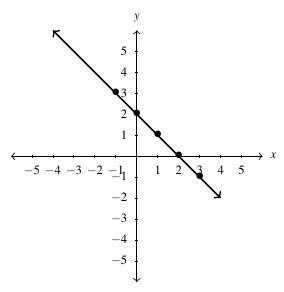
Answer to Exercise 93 - [latex]g(t) = \dfrac{t - 2}{3}[/latex], Domain: [latex](-\infty, \infty)[/latex], Range: [latex](-\infty, \infty)[/latex]
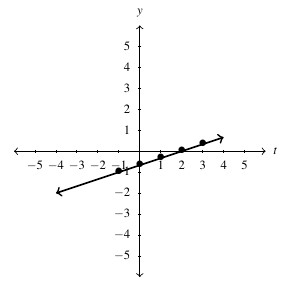
Answer to Exercise 94 - [latex]h(s) = s^2+1[/latex], Domain: [latex](-\infty, \infty)[/latex], Range: [latex][1, \infty)[/latex]
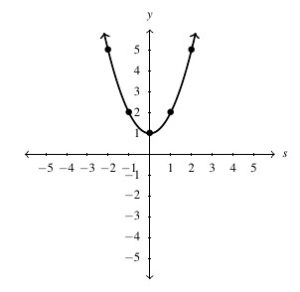
Answer to Exercise 95 - [latex]f(x) = 4-x^2[/latex], Domain: [latex](-\infty, \infty)[/latex], Range: [latex](-\infty, 4][/latex]
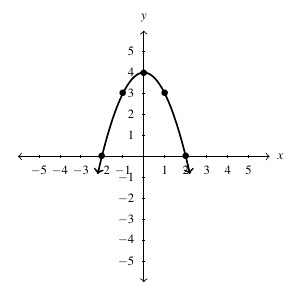
Answer to Exercise 96 - [latex]g(t) = 2[/latex], Domain: [latex](-\infty, \infty)[/latex], Range: [latex]\{2\}[/latex]
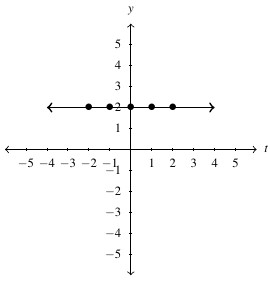
Answer to Exercise 97 - [latex]h(s) = s^3[/latex], Domain: [latex](-\infty, \infty)[/latex], Range: [latex](-\infty, \infty)[/latex]
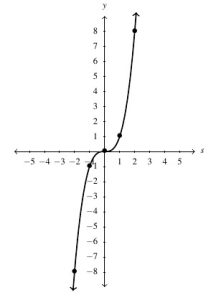
Answer to Exercise 98 - [latex]f(x) = x(x-1)(x+2)[/latex], Domain: [latex](-\infty, \infty)[/latex], Range: [latex](-\infty, \infty)[/latex]
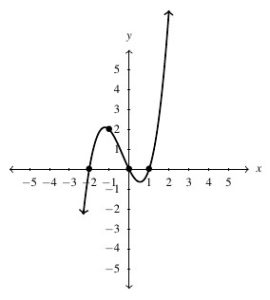
Answer to Exercise 99 - [latex]g(t) = \sqrt{t-2}[/latex], Domain: [latex][2, \infty)[/latex], Range: [latex][0, \infty)[/latex]
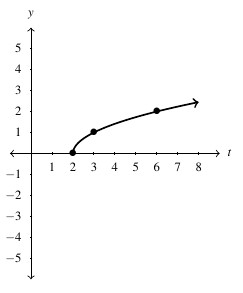
Answer to Exercise 100 - [latex]h(s) = \sqrt{5 - s}[/latex], Domain: [latex](-\infty, 5][/latex], Range: [latex][0, \infty)[/latex]
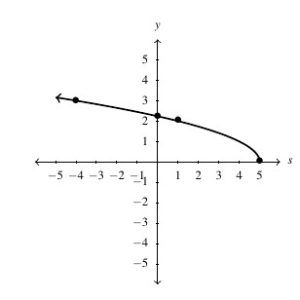
Answer to Exercise 101 - [latex]f(x) = 3-2\sqrt{x+2}[/latex], Domain: [latex][-2,\infty)[/latex], Range: [latex](-\infty, 3][/latex]
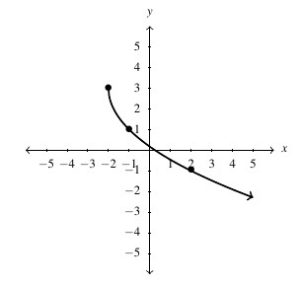
Answer to Exercise 102 - [latex]g(t) = \sqrt[3]{t}[/latex], Domain: [latex](-\infty, \infty)[/latex], Range: [latex](-\infty, \infty)[/latex]
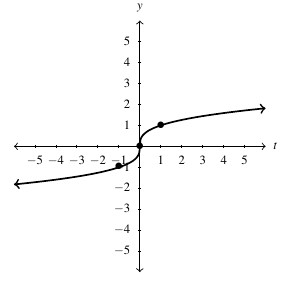
Answer to Exercise 103 - [latex]h(s) = \dfrac{1}{s^{2} + 1}[/latex], Domain: [latex](-\infty, \infty)[/latex], Range: [latex](0, 1][/latex]
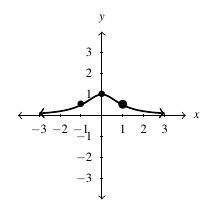
Answer to Exercise 104 - .
- domain [latex]= \{ -1, 0, 1, 2 \}[/latex], range [latex]= \{ -3, 0, 4\}[/latex]
- [latex]f(0) = -3[/latex], [latex]f(x) = 0[/latex] for [latex]x = -1, 1[/latex]
- [latex]f = \{ (-1,0), (0, -3), (1,0), (2,4) \}[/latex]
-
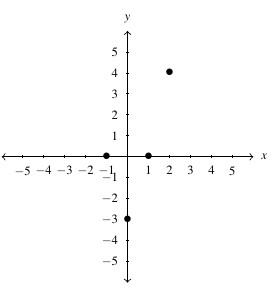
Answer to Exercise 105d
- .
- domain [latex]= \{ -1, 0, 2, 3 \}[/latex], range [latex]=\{ 2, 3, 4 \}[/latex]
-
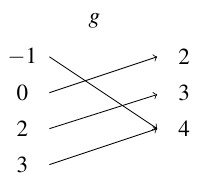
Answer to Exercise 106b - Find [latex]g(0) = 2[/latex] and [latex]g(x) = 0[/latex] has no solutions.
-
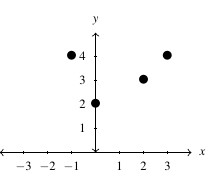
Answer to Exercise 106d
- [latex]F(4) = 4^2 = 16[/latex] (when [latex]t = 4[/latex]), the solutions to [latex]F(x) = 4[/latex] are [latex]x = \pm 2[/latex] (when [latex]t = \pm 2[/latex]).
- [latex]G(4) = 7[/latex] (when [latex]t = 2[/latex]), the solution to [latex]G(t) = 4[/latex] is [latex]x = -2[/latex] (when [latex]t = -1[/latex])
- [latex]A(3) = 9[/latex], so the area enclosed by a square with a side of length 3 inches is 9 square inches. The solutions to [latex]A(\ell) = 36[/latex] are [latex]\ell = \pm 6[/latex]. because [latex]\ell[/latex] is restricted to [latex]\ell > 0[/latex], we only keep [latex]\ell = 6[/latex]. This means for the area enclosed by the square to be 36 square inches, the length of the side needs to be 6 inches. because [latex]\ell[/latex] represents a length, [latex]\ell > 0.[/latex]
- [latex]A(2) = 4\pi[/latex], so the area enclosed by a circle with radius 2 meters is [latex]4\pi[/latex] square meters. The solutions to [latex]A(r) = 16\pi[/latex] are [latex]r = \pm 4[/latex]. because [latex]r[/latex] is restricted to [latex]r > 0,[/latex] we only keep [latex]r = 4.[/latex] This means for the area enclosed by the circle to be [latex]16\pi[/latex] square meters, the radius needs to be 4 meters. because [latex]r[/latex] represents a radius (length), [latex]r > 0.[/latex]
- [latex]V(5) = 125[/latex], so the volume enclosed by a cube with a side of length 5 centimeters is 125 cubic centimeters. The solution to [latex]V(s) = 27[/latex] is [latex]s = 3[/latex]. This means for the volume enclosed by the cube to be [latex]27[/latex] cubic centimeters, the length of the side needs to 3 centimeters. because [latex]x[latex] represents a length, [latex]x > 0[/latex].
- [latex]V(3) = 36\pi[/latex], so the volume enclosed by a sphere with radius 3 feet is [latex]36\pi[/latex] cubic feet. The solution to [latex]V(r) = \frac{32\pi}{3}[/latex] is [latex]r = 2[/latex]. This means for the volume enclosed by the sphere to be [latex]\frac{32\pi}{3}[/latex] cubic feet, the radius needs to 2 feet. because [latex]r[latex] represents a radius (length), [latex]r > 0[/latex].
- [latex]h(0) = 64[/latex], so at the moment the object is dropped off the building, the object is 64 feet off of the ground. The solutions to [latex]h(t) = 0[/latex] are [latex]t = \pm 2[/latex]. because we restrict [latex]0 \leq t \leq 2[/latex], we only keep [latex]t = 2[/latex]. This means 2 seconds after the object is dropped off the building, it is 0 feet off the ground. Said differently, the object hits the ground after 2 seconds. The restriction [latex]0 \leq t \leq 2[/latex] restricts the time to be between the moment the object is released and the moment it hits the ground.
- [latex]T(0) = 3[/latex], so at 6 AM (0 hours after 6 AM), it is [latex]3^{\circ}[/latex] Fahrenheit. [latex]T(6) = 33[/latex], so at noon (6 hours after 6 AM), the temperature is [latex]33^{\circ}[/latex] Fahrenheit. [latex]T(12) = 27[/latex], so at 6 PM (12 hours after 6 AM), it is [latex]27^{\circ}[/latex] Fahrenheit.
- [latex]C(0) = 27[/latex], so to make 0 pens, it costs[1] $2700. [latex]C(2) = 11[/latex], so to make 2000 pens, it costs $1100. [latex]C(5) = 2[/latex], so to make 5000 pens, it costs $2000.
- [latex]E(0) = 16.00[/latex], so in 1980 (0 years after 1980), the average fuel economy of passenger cars in the US was 16.00 miles per gallon. [latex]E(14) = 20.81[/latex], so in 1994 (14 years after 1980), the average fuel economy of passenger cars in the US was 20.81 miles per gallon. [latex]E(28) = 22.64[/latex], so in 2008 (28 years after 1980), the average fuel economy of passenger cars in the US was 22.64 miles per gallon.
- [latex]P(s) = 4s[/latex], [latex]s > 0[/latex].
- [latex]C(D) = \pi D[/latex], [latex]D > 0[/latex].
- .
- The amount in the retirement account after 30 years if the monthly payment is $50.
- The solution to [latex]A(P) = 250000[/latex] is what the monthly payment needs to be in order to have $250,000 in the retirement account after 30 years.
- [latex]A(P+50)[/latex] is how much is in the retirement account in 30 years if $50 is added to the monthly payment [latex]P[/latex]. [latex]A(P)+50[/latex] represents the amount of money in the retirement account after 30 years if [latex]P[/latex] dollars is invested each month plus an additional $50. [latex]A(P)+A(50)[/latex] is the sum of money from two retirement accounts after 30 years: one with monthly payment [latex]P[/latex] dollars and one with monthly payment $50.
- .
- because noon is 4 hours after 8 AM, [latex]P(4)[/latex] gives the chance of precipitation at noon.
- We would need to solve [latex]P(t) \geq 50 \%[/latex] or [latex]P(t) \geq 0.5[/latex].
- The graph in question passes the horizontal line test meaning for each [latex]w[/latex] there is only one [latex]v.[/latex] The domain of [latex]g[/latex] is [latex][0, \infty)[/latex] (which is the range of [latex]f[/latex]) and the range of [latex]g[/latex] is [latex][2, \infty)[/latex] which is the domain of [latex]f[/latex].
- Answers vary.
Section 1.3 Answers
- [latex]y+1 = 3(x-3)[/latex] and [latex]y = 3x-10[/latex]
- [latex]y-8 = -2(x+5)[/latex]and [latex]y = -2x-2[/latex]
- [latex]y + 1 = -(x+7)[/latex] and [latex]y = -x-8[/latex]
- [latex]y - 1 = \frac{2}{3} (x+2)[/latex] and [latex]y = \frac{2}{3} x + \frac{7}{3}[/latex]
- [latex]y - 4 = -\frac{1}{5} (x-10)[/latex] and [latex]y = -\frac{1}{5} x + 6[/latex]
- [latex]y - 4 = \frac{1}{7}(x + 1)[/latex] and [latex]y = \frac{1}{7}x + \frac{29}{7}[/latex]
- [latex]y - 117 = 0[/latex] and [latex]y = 117[/latex]
- [latex]y + 3 = -\sqrt{2}(x - 0)[/latex] and [latex]y = -\sqrt{2}x - 3[/latex]
- [latex]y - 2\sqrt{3} = -5(x - \sqrt{3})[/latex] and [latex]y = -5x + 7\sqrt{3}[/latex]
- [latex]y + 12 = 678(x + 1)[/latex] and [latex]y = 678x + 666[/latex]
- [latex]y = -\frac{5}{3}x[/latex]
- [latex]y = -2[/latex]
- [latex]y = \frac{8}{5}x - 8[/latex]
- [latex]y = \frac{9}{4}x - \frac{47}{4}[/latex]
- [latex]y = 5[/latex]
- [latex]y = -8[/latex]
- [latex]y = -\frac{5}{4} x + \frac{11}{8}[/latex]
- [latex]y = 2x + \frac{13}{6}[/latex]
- [latex]y = -x[/latex]
- [latex]y = \frac{\sqrt{3}}{3} x[/latex]
- [latex]y =2x-1[/latex], slope: [latex]m = 2[/latex], [latex]y[/latex]-intercept: [latex](0,-1)[/latex], [latex]x[/latex]-intercept: [latex]\left(\frac{1}{2}, 0 \right)[/latex]
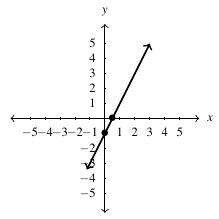
Answer to Exercise 21 - [latex]y =3-x[/latex], slope: [latex]m = -1[/latex], [latex]y[/latex]-intercept: [latex](0,3)[/latex], [latex]x[/latex]-intercept: [latex](3, 0)[/latex]
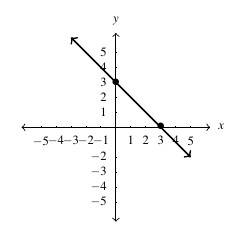
Answer to Exercise 22 - [latex]y = 3[/latex], slope: [latex]m =0[/latex], [latex]y[/latex]-intercept: [latex](0,3)[/latex], [latex]x[/latex]-intercept: none
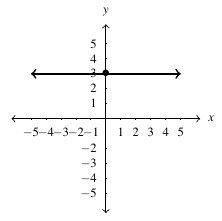
Answer to Exercise 23 - [latex]y = 0[/latex], slope: [latex]m =0[/latex], [latex]y[/latex]-intercept: [latex](0,0)[/latex], [latex]x[/latex]-intercept: [latex]\{ (x,0) \, | \, x \text{ is a real number} \}[/latex]
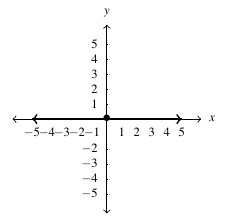
Answer to Exercise 24 - [latex]y = \frac{2}{3} x + \frac{1}{3}[/latex], slope: [latex]m = \frac{2}{3}[/latex], [latex]y[/latex]-intercept: [latex]\left(0, \frac{1}{3}\right)[/latex], [latex]x[/latex]-intercept: [latex]\left(-\frac{1}{2}, 0\right)[/latex]
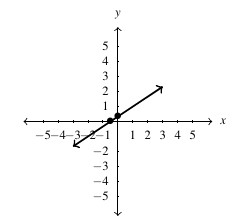
Answer to Exercise 25 - [latex]y = \dfrac{1-x}{2}[/latex], slope: [latex]m = -\frac{1}{2}[/latex], [latex]y[/latex]-intercept: [latex]\left(0, \frac{1}{2}\right)[/latex], [latex]x[/latex]-intercept: [latex]\left(1, 0\right)[/latex]
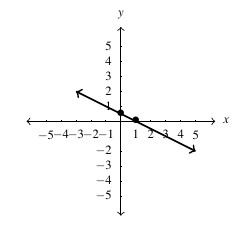
Answer to Exercise 26 - [latex]w = -\frac{3}{2} v + 3[/latex], slope: [latex]m = -\frac{3}{2}[/latex], [latex]w[/latex]-intercept: [latex]\left(0, 3\right)[/latex], [latex]v[/latex]-intercept: [latex]\left(2, 0\right)[/latex]
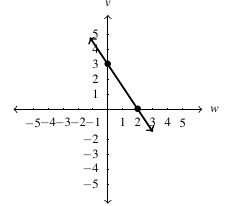
Answer to Exercise 27 - [latex]v = -\frac{2}{3} w + 2[/latex], slope: [latex]m = -\frac{2}{3}[/latex], [latex]v[/latex]-intercept: [latex]\left(0,2 \right)[/latex], [latex]w[/latex]-intercept: [latex]\left(3,0\right)[/latex]
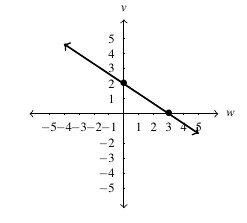
Answer to Exercise 28 - [latex](-1,-1)[/latex] and [latex]\left(\frac{11}{5}, \frac{27}{5}\right)[/latex]
- [latex]y = 3x[/latex]
- [latex]y = -6x + 20[/latex]
- [latex]y = \frac{2}{3} x - 4[/latex]
- [latex]y = -\frac{1}{3} x - \frac{2}{3}[/latex]
- [latex]y=-2[/latex]
- [latex]x=-5[/latex]
- [latex]y = -3x[/latex]
- [latex]y = \frac{1}{6}x + \frac{3}{2}[/latex]
- [latex]y = -\frac{3}{2} x +9[/latex]
- [latex]y = 3x-4[/latex]
- [latex]x=3[/latex]
- [latex]y=0[/latex]
- [latex]f(x) =2x-1[/latex], slope: [latex]m = 2[/latex], [latex]y[/latex]-intercept: [latex](0,-1)[/latex], [latex]x[/latex]-intercept: [latex]\left(\frac{1}{2}, 0 \right)[/latex]

Answer to Exercise 42 - [latex]g(t) =3-t[/latex], slope: [latex]m = -1[/latex], [latex]y[/latex]-intercept: [latex](0,3)[/latex], [latex]t[/latex]-intercept: [latex](3, 0)[/latex]

Answer to Exercise 43 - [latex]F(w) = 3[/latex], slope: [latex]m =0[/latex], [latex]y[/latex]-intercept: [latex](0,3)[/latex], [latex]w[/latex]-intercept: none

Answer to Exercise 44 - [latex]G(s) = 0[/latex], slope: [latex]m =0[/latex], [latex]y[/latex]-intercept: [latex](0,0)[/latex], [latex]s[/latex]-intercept: [latex]\{ (s,0) \, | \, s\text{ is a real number} \}[/latex]

Answer to Exercise 45 - [latex]h(t) = \frac{2}{3} x + \frac{1}{3}[/latex], slope: [latex]m = \frac{2}{3}[/latex], [latex]y[/latex]-intercept: [latex]\left(0, \frac{1}{3}\right)[/latex], [latex]t[/latex]-intercept: [latex]\left(-\frac{1}{2}, 0\right)[/latex]

Answer to Exercise 46 - [latex]h(t) = \frac{2}{3} x + \frac{1}{3}[/latex], slope: [latex]m = \frac{2}{3}[/latex], [latex]y[/latex]-intercept: [latex]\left(0, \frac{1}{3}\right)[/latex], [latex]t[/latex]-intercept: [latex]\left(-\frac{1}{2}, 0\right)[/latex]

Answer to Exercise 47 - domain: [latex](-\infty, \infty)[/latex], range: [latex][1, \infty)[/latex], [latex]y[/latex]-intercept: [latex](0,4)[/latex], [latex]x[/latex]-intercept: none
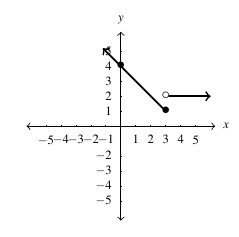
Answer to Exercise 48 - domain: [latex](-\infty, \infty)[/latex], range: [latex][0, \infty)[/latex], [latex]y[/latex]-intercept: [latex](0,2)[/latex], [latex]x[/latex]-intercept: [latex](2,0)[/latex]
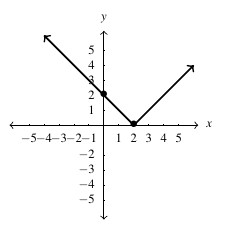
Answer to Exercise 49 - domain: [latex](-\infty, \infty)[/latex], range: [latex](-4, \infty)[/latex], [latex]y[/latex]-intercept: [latex](0,0)[/latex], [latex]t[/latex]-intercepts: [latex](-2,0)[/latex], [latex](0,0)[/latex]
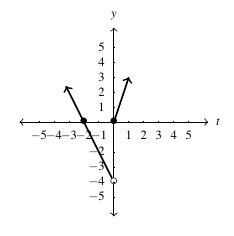
Answer to Exercise 50 - domain: [latex](-\infty, \infty)[/latex], range: [latex][-3, 3][/latex], [latex]y[/latex]-intercept: [latex](0,-3)[/latex], [latex]t[/latex]-intercept: [latex]\left(\frac{3}{2}, 0 \right) = (1.5,0)[/latex]
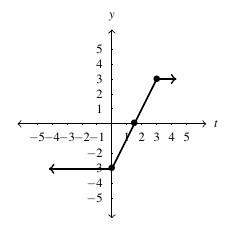
Answer to Exercise 51 - .
-
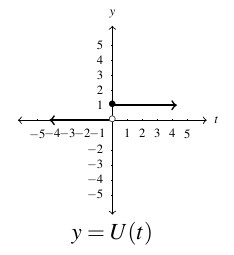
Answer to Exercise 52a - domain: [latex](-\infty, \infty)[/latex], range: [latex]\{ 0, 1\}[/latex]
- [latex]U[/latex] is constant on [latex](-\infty, 0)[/latex] and [latex][0, \infty).[/latex]
- [latex]U(t-2) = \left\{ \begin{array}{cc} 0 & \text{if } t \text{ }2, \\ 1 & \text{if } t \geq 2 \\ \end{array} \right.[/latex]
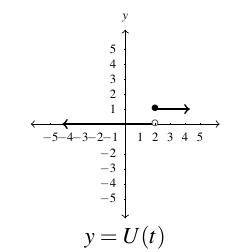
Answer to Exercise 52d
-
- [latex]f(x) = -3[/latex]
Section 1.4 Answers
- [latex]f(x) = |x + 4|[/latex]
- [latex]x[/latex]-intercept [latex](-4, 0)[/latex]
- [latex]y[/latex]-intercept [latex](0, 4)[/latex]
- Domain [latex](-\infty, \infty)[/latex]
- Range [latex][0, \infty)[/latex]
- Decreasing on [latex](-\infty, -4][/latex]
- Increasing on [latex][-4, \infty)[/latex]
- Minimum is 0 at [latex](-4,0)[/latex]
- No maximum
-
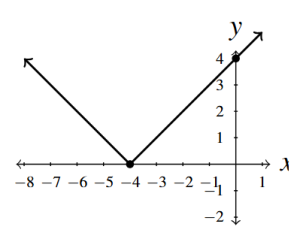
Answer to Exercise 1
- [latex]f(x) = |x| + 4[/latex]
- No [latex]x[/latex]-intercepts
- [latex]y[/latex]-intercept [latex](0, 4)[/latex]
- Domain [latex](-\infty, \infty)[/latex]
- Range [latex][4, \infty)[/latex]
- Decreasing on [latex](-\infty, 0][/latex]
- Increasing on [latex][0, \infty)[/latex]
- Minimum is 4 at [latex](0,4)[/latex]
- No maximum
-
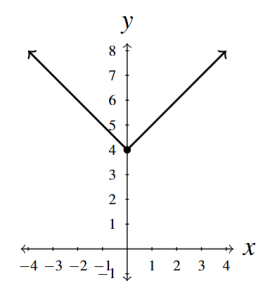
Answer to Exercise 2
- [latex]f(x) = |4x|[/latex]
- [latex]x[/latex]-intercept [latex](0, 0)[/latex]
- [latex]y[/latex]-intercept [latex](0, 0)[/latex]
- Domain [/latex](-\infty, \infty)[latex]
- Range [latex][0, \infty)[/latex]
- Decreasing on [latex](-\infty, 0][/latex]
- Increasing on [latex][0, \infty)[/latex]
- Minimum is 0 at [latex](0,0)[latex]
- No maximum
- [caption id="attachment_833" align="alignnone" width="150"]
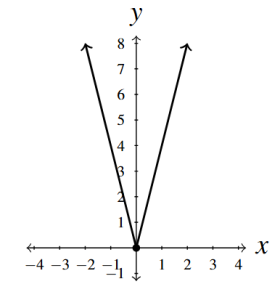 Answer to Exercise 3[/caption]
Answer to Exercise 3[/caption]
- [latex]g(t) = -3|t|[/latex]
- [latex]t[/latex]-intercept [latex](0, 0)[/latex]
- [latex]y[/latex]-intercept [latex](0, 0)[/latex]
- Domain [latex](-\infty, \infty)[/latex]
- Range [latex](-\infty, 0][/latex]
- Increasing on [latex](-\infty, 0][/latex]
- Decreasing on [latex][0, \infty)[/latex]
- Maximum is 0 at [latex](0, 0)[/latex]
- No minimum
-
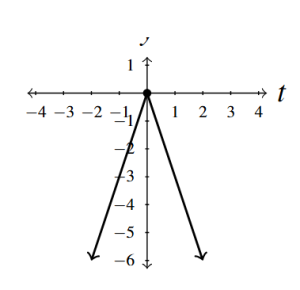
Answer to Exercise 4
- [latex]g(t) = 3|t + 4| - 4[/latex]
- [latex]t[/latex]-intercepts [latex]\left(-\frac{16}{3}, 0\right)[/latex]
- [latex]\left(-\frac{8}{3}, 0\right)[/latex]
- [latex]y[/latex]-intercept [latex](0, 8)[/latex]
- Domain [latex](-\infty, \infty)[/latex]
- Range [latex][-4, \infty)[/latex]
- Decreasing on [latex](-\infty, -4][/latex]
- Increasing on [latex][-4, \infty)[/latex]
- Minimum is [latex]-4[/latex] at [latex](-4,-4)[/latex]
- No maximum
-
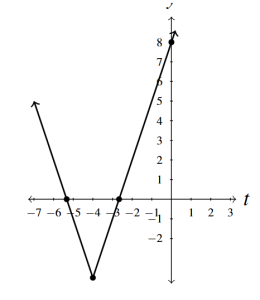
Answer to Exercise 5
- [latex]g(t) = \frac{1}{3}|2t - 1|[/latex]
- [latex]t[/latex]-intercepts [latex]\left(\frac{1}{2}, 0\right)[/latex]
- [latex]y[/latex]-intercept [latex]\left(0, \frac{1}{3}\right)[/latex]
- Domain [latex](-\infty, \infty)[/latex]
- Range [latex][0, \infty)[/latex]
- Decreasing on [latex]\left(-\infty, \frac{1}{2}\right][/latex]
- Increasing on [latex]\left[\frac{1}{2}, \infty\right)[/latex]
- Minimum is 0 at [latex]\left(\frac{1}{2},0\right)[/latex]
- No maximum
-
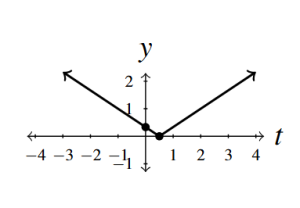
Answer to Exercise 6
- [latex]F(x) = 2|x+1|-3[/latex]
- [latex]F(x) = |x-1.25|-2.75[/latex]
- [latex]F(x) = -|x+1|+2[/latex]
- [latex]F(x) = -\frac{1}{2} |x+1|+\frac{3}{2}[/latex]
- In each case, the graph of [latex]g[/latex] can be obtained from the graph of [latex]f[/latex] by reflecting the portion of the graph of [latex]f[/latex] which lies below the [latex]x[/latex]-axis about the [latex]x[/latex]-axis. This meshes with Definition 1.12 because what we are doing algebraically is making the negative [latex]y[/latex]-values positive.
- If [latex]F(x) = a|x-h| + k[/latex], then for the vertex to be at [latex](1,-2)[/latex], [latex]h =1[/latex] and [latex]k = -2[/latex] so [latex]F(x) = a |x-1| - 2[/latex]. Because [latex](0,-1)[/latex] is on the graph, [latex]F(0) = -1[/latex] so [latex]-1 = a|0-1|-2[/latex] which means [latex]a = 1[/latex]. This means [latex]F(x) = |x-1|-2[/latex]. However, [latex](2.6,0)[/latex] is also on the graph, so it should work out that [latex]F(2.6) = 0[/latex]. However, we find [latex]F(2.6) = |2.6-1| - 2 = -0.4 \neq 0[/latex].
- [latex]F(x) = \left\{ \begin{array}{lr}-x-1 & \text{if} x \leq 1, \\\frac{5}{4} x - \frac{13}{4} & \text{if } x \geq 1, \\\end{array} \right.[/latex]
- Re-write [latex]f(x) = x+|x| - 3[/latex] as [latex]\displaystyle{ f(x) = \left\{ \begin{array}{rcl} -3 & \text{ if } & x 0\\ 2x -3 & \text{ if } & x \geq 0 \\ \end{array} \right.}[/latex]
- [latex]x[/latex]-intercept [latex]\left(\frac{3}{2}, 0\right)[/latex]
- [latex]y[/latex]-intercept [latex](0,-3)[/latex]
- Domain [latex](-\infty, \infty)[/latex]
- Range [latex][-3, \infty)[/latex]
- Increasing on [latex][0,\infty)[/latex]
- Constant on [latex](-\infty, 0][/latex]
- Minimum is [latex]-3[/latex] at [latex](x,-3)[/latex] where [latex]x \leq 0[/latex]
- No maximum
-
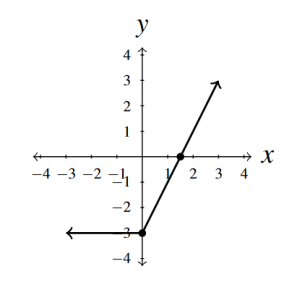
Answer to Exercise 13
- Re-write [latex]f(x) = |x+2| - x[/latex] as [latex]\displaystyle{ f(x) = \left\{ \begin{array}{rcl} -2x-2 & \text{ if } & x -2\\ 2 & \text{ if } & x \geq -2 \\ \end{array} \right. }[/latex]
- No [latex]x[/latex]-intercepts
- [latex]y[/latex]-intercept [latex](0,2)[/latex]
- Domain [latex](-\infty, \infty)[/latex]
- Range [latex][2, \infty)[/latex]
- Decreasing on [latex](-\infty, -2][/latex]
- Constant on [latex][-2,\infty)[/latex]
- Minimum is 2 at every point [latex](x,2)[/latex] where [latex]x \geq -2[/latex]
- No maximum
-
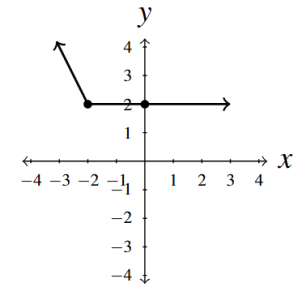
Answer to Exercise 14
- Re-write [latex]f(x) = |x+2|-|x|[/latex] as \\ [latex]\displaystyle{ f(x) = \left\{ \begin{array}{rcl} -2 & \text{ if } & x -2\\ 2x+2 & \text{ if } & -2 \leq x 0 \\ 2 & \text{ if } & x \geq 0 \\ \end{array} \right. }[/latex]
- [latex]x[/latex]-intercept [latex]\left(-1, 0\right)[/latex]
- [latex]y[/latex]-intercept [latex](0,2)[/latex]
- Domain [latex](-\infty, \infty)[/latex]
- Range [latex][-2,2][/latex]
- Increasing on [latex][-2,0][/latex]
- Constant on [latex](-\infty, -2][/latex]
- Constant on [latex][0,\infty)[/latex]
- Minimum is [latex]-2[/latex] at [latex](x,-2)[/latex] where [latex]x \leq -2[/latex]
- Maximum is 2 at [latex](x,2)[/latex] where [latex]x \geq 0[/latex]
-
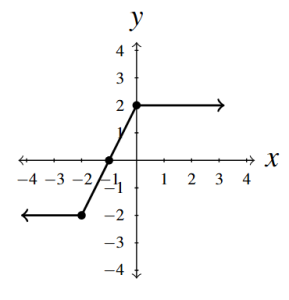
Answer to Exercise 15
- Re-write [latex]g(t) = |t+ 4| + |t - 2|[/latex] as [latex]\displaystyle{ g(t) = \left\{ \begin{array}{rcl}-2t - 2 & \text{ if } & t -4\\ 6 & \text{ if } & -4 \leq t 2\\ 2t + 2 & \text{ if } & t \geq 2 \end{array} \right. }[/latex]
- No [latex]t[/latex]-intercept
- [latex]y[/latex]-intercept [latex](0, 6)[/latex]
- Domain [latex](-\infty, \infty)[/latex]
- Range [latex][6, \infty)[/latex]
- Decreasing on [latex](-\infty, -4][/latex]
- Constant on [latex][-4, 2][/latex]
- Increasing on [latex][2, \infty)[/latex]
- Minimum is 6 at [latex](t, 6)[/latex] where [latex]-4 \leq t \leq 2[/latex]
- No maximum
-
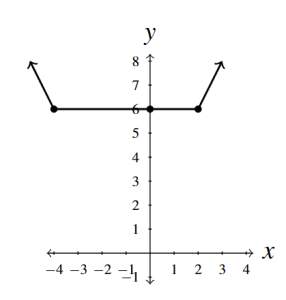
Answer to Exercise 16
- Re-write [latex]g(t) = \dfrac{|t + 4|}{t + 4}[/latex] as [latex]\displaystyle{ g(t) = \left\{ \begin{array}{rcl} -1 & \text{ if } & t -4\\ 1 & \text{ if } & t > -4 \end{array} \right. }[/latex]
- No [latex]t[/latex]-intercept
- [latex]y[/latex]-intercept [latex](0, 1)[/latex]
- Domain [latex](-\infty, -4) \cup (-4, \infty)[/latex]
- Range [latex]\{-1, 1\}[/latex]
- Constant on [latex](-\infty, -4)[/latex]
- Constant on [latex](-4, \infty)[/latex]
- Minimum is [latex]-1[/latex] at every point [latex](t, -1)[/latex] where [latex]t -4[/latex]
- Maximum is 1 at [latex](t, 1)[/latex] where [latex]t > -4[/latex]
-
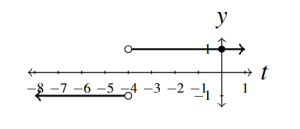
Answer to Exercise 17
- Re-write [latex]g(t) = \dfrac{|2-t|}{2-t}[/latex] as [latex]\displaystyle{ g(t) = \left\{ \begin{array}{rcl}1 & \text{ if } & t 2\\ -1 & \text{ if } & t > 2 \end{array} \right. }[/latex]
- No [latex]t[/latex]-intercept
- [latex]y[/latex]-intercept [latex](0, 1)[/latex]
- Domain [latex](-\infty, 2) \cup (2, \infty)[/latex]
- Range [latex]\{-1, 1\}[/latex]
- Constant on [latex](-\infty, 2)[/latex]
- Constant on [latex](2, \infty)[/latex]
- Minimum is [latex]-1[/latex] at [latex](t, -1)[/latex] where [latex]t > 2[/latex]
- Maximum is 1 at every point [latex](t, 1)[/latex] where [latex]t[/latex] < 2
-
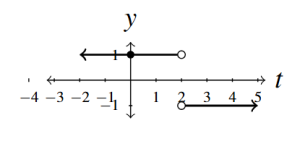
Answer to Exercise 18
- [latex]f(x) = | |x|-4|[/latex]
- [latex]x = -6[/latex] or [latex]x=6[/latex]
- [latex]x = -3[/latex] or [latex]x= \frac{11}{3}[/latex]
- [latex]x = -3[/latex] or [latex]x= 11[/latex]
- [latex]t = -1[/latex] or [latex]t= 1[/latex]
- [latex]t=-\frac{1}{2}[/latex] or [latex]t= \frac{1}{10}[/latex]
- no solution
- [latex]w=-3[/latex] or [latex]w= 3[/latex]
- [latex]w = -\frac{13}{8}[/latex] or [latex]w = \frac{53}{8}[/latex]
- [latex]w =-\frac{3}{2}[/latex]
- [latex]x=0[/latex] or [latex]x= 2[/latex]
- [latex]x=1[/latex]
- no solution
- [latex]x = -1[/latex] or [latex]x = 9[/latex]
- [latex]x = -\frac{1}{7}[/latex] or [latex]x = 1[/latex]
- [latex]x = 0[/latex] or [latex]x = 2[/latex]
- [latex]t=1[/latex]
- [latex]t = -\frac{3}{10}[/latex]
- [latex]t = \frac{1}{5}[/latex] or [latex]t = 5[/latex]
- [latex]\left[\frac{1}{3}, 3\right][/latex]
- [latex]\left(-\infty, -\frac{12}{7} \right) \cup \left(\frac{8}{7}, \infty\right)[/latex]
- [latex](-3,2)[/latex]
- [latex](-\infty,1] \cup [3,\infty)[/latex]
- No solution
- [latex](-\infty, \infty)[/latex]
- [latex](-3,2] \cup [6,11)[/latex]
- [latex][3, 4) \cup (5, 6][/latex]
- [latex]\left[-\frac{12}{7}, -\frac{6}{5}\right][/latex]
- [latex](-\infty, -4) \cup \left( \frac{2}{3}, \infty\right)[/latex]
- [latex]\left(-\infty, -\frac{4}{3} \right] \cup [6, \infty)[/latex]
- [latex](-\infty, -5)[/latex]
- No Solution.
- [latex]\left[ -7, \frac{5}{3}\right][/latex]
- [latex]\left( 1, \frac{5}{3} \right)[/latex]
- [latex](-\infty, \infty)[/latex]
- Answers May Vary
- Answers May Vary
Section 1.5 Answers
- For [latex]f(x) = 3x+1[/latex] and [latex]g(x) = 4-x[/latex]
- [latex](f+g)(2) = 9[/latex]
- [latex](f-g)(-1) = -7[/latex]
- [latex](g-f)(1) = -1[/latex]
- [latex](fg)\left(\frac{1}{2}\right) = \frac{35}{4}[/latex]
- [latex]\left(\frac{f}{g}\right)(0) = \frac{1}{4}[/latex]
- [latex]\left(\frac{g}{f}\right)\left(-2\right) = -\frac{6}{5}[/latex]
- For [latex]f(x) = x^2[/latex] and [latex]g(x) = -2x+1[/latex]
-
[latex](f+g)(2) = 1[/latex]
-
[latex](f-g)(-1) = -2[/latex]
-
[latex](g-f)(1) = -2[/latex]
-
[latex](fg)\left(\frac{1}{2}\right) = 0[/latex]
-
[latex]\left(\frac{f}{g}\right)(0) = 0[/latex]
-
[latex]\left(\frac{g}{f}\right)\left(-2\right) = \frac{5}{4}[/latex]
-
- For [latex]f(x) = x^2 - x[/latex] and [latex]g(x) = 12-x^2[/latex]
-
[latex](f+g)(2) = 10[/latex]
-
[latex](f-g)(-1) = -9[/latex]
-
[latex](g-f)(1) = 11[/latex]
-
[latex](fg)\left(\frac{1}{2}\right) = -\frac{47}{16}[/latex]
-
[latex]\left(\frac{f}{g}\right)(0) = 0[/latex]
-
[latex]\left(\frac{g}{f}\right)\left(-2\right) = \frac{4}{3}[/latex]
-
- For [latex]f(x) = 2x^3[/latex] and [latex]g(x) = -x^2-2x-3[/latex]
-
[latex](f+g)(2) = 5[/latex]
-
[latex](f-g)(-1) = 0[/latex]
-
[latex](g-f)(1) = -8[/latex]
-
[latex](fg)\left(\frac{1}{2}\right) = -\frac{17}{16}[/latex]
-
[latex]\left(\frac{f}{g}\right)(0) = 0[/latex]
-
[latex]\left(\frac{g}{f}\right)\left(-2\right) = \frac{3}{16}[/latex]
-
- For [latex]f(x) = \sqrt{x+3}[/latex] and [latex]g(x) = 2x-1[/latex]
-
[latex](f+g)(2) = 3+\sqrt{5}[/latex]
-
[latex](f-g)(-1) = 3+\sqrt{2}[/latex]
-
[latex](g-f)(1) = -1[/latex]
-
[latex](fg)\left(\frac{1}{2}\right) = 0[/latex]
-
[latex]\left(\frac{f}{g}\right)(0) = -\sqrt{3}[/latex]
-
[latex]\left(\frac{g}{f}\right)\left(-2\right) = -5[/latex]
-
- For [latex]f(x) = \sqrt{4-x}[/latex] and [latex]g(x) = \sqrt{x+2}[/latex]
-
[latex](f+g)(2) = 2+\sqrt{2}[/latex]
-
[latex](f-g)(-1) = -1+\sqrt{5}[/latex]
-
[latex](g-f)(1) = 0[/latex]
-
[latex](fg)\left(\frac{1}{2}\right) = \frac{\sqrt{35}}{2}[/latex]
-
[latex]\left(\frac{f}{g}\right)(0) = \sqrt{2}[/latex]
-
[latex]\left(\frac{g}{f}\right)\left(-2\right) = 0[/latex]
-
- For [latex]f(x) = 2x[/latex] and [latex]g(x) = \frac{1}{2x+1}[/latex]
-
[latex](f+g)(2) = \frac{21}{5}[/latex]
-
[latex](f-g)(-1) = -1[/latex]
-
[latex](g-f)(1) = -\frac{5}{3}[/latex]
-
[latex](fg)\left(\frac{1}{2}\right) = \frac{1}{2}[/latex]
-
[latex]\left(\frac{f}{g}\right)(0) = 0[/latex]
-
[latex]\left(\frac{g}{f}\right)\left(-2\right) = \frac{1}{12}[/latex]
-
- For [latex]f(x) = x^2[/latex] and [latex]g(x) = \frac{3}{2x-3}[/latex]
-
[latex](f+g)(2) = 7[/latex]
-
[latex](f-g)(-1) = \frac{8}{5}[/latex]
-
[latex](g-f)(1) = -4[/latex]
-
[latex](fg)\left(\frac{1}{2}\right) = -\frac{3}{8}[/latex]
-
[latex]\left(\frac{f}{g}\right)(0) = 0[/latex]
-
[latex]\left(\frac{g}{f}\right)\left(-2\right) = -\frac{3}{28}[/latex]
-
- For [latex]f(x) = x^2[/latex] and [latex]g(x) = \frac{1}{x^2}[/latex]
-
[latex](f+g)(2) =\frac{17}{4}[/latex]
-
[latex](f-g)(-1) = 0[/latex]
-
[latex](g-f)(1) = 0[/latex]
-
[latex](fg)\left(\frac{1}{2}\right) =1[/latex]
-
[latex]\left(\frac{f}{g}\right)(0)[/latex] is undefined.
-
[latex]\left(\frac{g}{f}\right)\left(-2\right) = \frac{1}{16}[/latex]
-
- For [latex]f(x) = x^2+1[/latex] and [latex]g(x) = \frac{1}{x^2+1}[/latex]
-
[latex](f+g)(2) =\frac{26}{5}[/latex]
-
[latex](f-g)(-1) = \frac{3}{2}[/latex]
-
[latex](g-f)(1) = -\frac{3}{2}[/latex]
-
[latex](fg)\left(\frac{1}{2}\right) =1[/latex]
-
[latex]\left(\frac{f}{g}\right)(0) = 1[/latex]
-
[latex]\left(\frac{g}{f}\right)\left(-2\right) = \frac{1}{25}[/latex]
-
-
[latex](f + g)(-4) = -5[/latex]
-
[latex](f + g)(0) = 5[/latex]
-
[latex](f-g)(4) = -5[/latex]
-
[latex](fg)(-4) = 6[/latex]
-
[latex](fg)(-2) = 0[/latex]
-
[latex](fg)(4) = -6[/latex]
- [latex]\left(\dfrac{f}{g}\right)(0) = \dfrac{3}{2}[/latex]
- [latex]\left(\dfrac{f}{g}\right)(2) = 0[/latex]
- [latex]\left(\dfrac{g}{f}\right)(-1) = 0[/latex]
- The domains of [latex]f+g[/latex], [latex]f-g[/latex] and [latex]fg[/latex] are all [latex][-4,4][/latex]. The domain of [latex]\frac{f}{g}[/latex] is [latex][-4, -1) \cup (-1,4][/latex] and the domain of [latex]\frac{g}{f}[/latex] is [latex][-4, -2) \cup (-2,2) \cup (2, 4][/latex].
-
[latex](f + g)(-3) = 2[/latex]
-
[latex](f - g)(2) = 3[/latex]
-
[latex](fg)(-1) = 0[/latex]
-
[latex](g + f)(1) = 0[/latex]
-
[latex](g - f)(3) = 3[/latex]
-
[latex](gf)(-3) = -8[/latex]
-
[latex]\left(\frac{f}{g}\right)(-2)[/latex] does not exist
-
[latex]\left(\frac{f}{g}\right)(-1) = 0[/latex]
-
[latex]\left(\frac{f}{g}\right)(2) = 4[/latex]
-
[latex]\left(\frac{g}{f}\right)(-1)[/latex] does not exist
-
[latex]\left(\frac{g}{f}\right)(3) = -2[/latex]
-
[latex]\left(\frac{g}{f}\right)(-3) = -\frac{1}{2}[/latex]
- For [latex]f(x) = 2x+1[/latex] and [latex]g(x) = x-2[/latex]
-
[latex](f+g)(x) = 3x-1[/latex], Domain: [latex](-\infty, \infty)[/latex]
-
[latex](f-g)(x) = x+3[/latex], Domain: [latex](-\infty, \infty)[/latex]
-
[latex](fg)(x) = 2x^2-3x-2[/latex], Domain: [latex](-\infty, \infty)[/latex]
-
[latex]\left(\frac{f}{g}\right)(x) = \frac{2x+1}{x-2}[/latex], Domain: [latex](-\infty, 2) \cup (2, \infty)[/latex]
-
- For [latex]f(x) = 1-4x[/latex] and [latex]g(x) = 2x-1[/latex]
-
[latex](f+g)(x) = -2x[/latex], Domain: [latex](-\infty, \infty)[/latex]
-
[latex](f-g)(x) = 2-6x[/latex], Domain: [latex](-\infty, \infty)[/latex]
-
[latex](fg)(x) = -8x^2+6x-1[/latex], Domain: [latex](-\infty, \infty)[/latex]
-
[latex]\left(\frac{f}{g}\right)(x) = \frac{1-4x}{2x-1}[/latex], Domain: [latex]\left(-\infty, \frac{1}{2} \right) \cup \left(\frac{1}{2}, \infty \right)[/latex]
-
-
For [latex]f(x) = x^2[/latex] and [latex]g(x) = 3x-1[/latex]
-
[latex](f+g)(x) = x^2+3x-1[/latex], Domain: [latex](-\infty, \infty)[/latex]
-
[latex](f-g)(x) = x^2-3x+1[/latex], Domain: [latex](-\infty, \infty)[/latex]
-
[latex](fg)(x) = 3x^3-x^2[/latex], Domain: [latex](-\infty, \infty)[/latex]
-
[latex]\left(\frac{f}{g}\right)(x) = \frac{x^2}{3x-1}[/latex], Domain: [latex]\left(-\infty, \frac{1}{3} \right) \cup \left(\frac{1}{3}, \infty \right)[/latex]
-
-
For [latex]f(x) = x^2-x[/latex] and [latex]g(x) = 7x[/latex]
-
[latex](f+g)(x) = x^2+6x[/latex], Domain: [latex](-\infty, \infty)[/latex]
-
[latex](f-g)(x) = x^2-8x[/latex], Domain: [latex](-\infty, \infty)[/latex]
-
[latex](fg)(x) = 7x^3-7x^2[/latex], Domain: [latex](-\infty, \infty)[/latex]
-
[latex]\left(\frac{f}{g}\right)(x) = \frac{x-1}{7}[/latex], Domain: [latex]\left(-\infty, 0 \right) \cup \left(0, \infty \right)[/latex]
-
-
For [latex]f(x) = x^2-4[/latex] and [latex]g(x) = 3x+6[/latex]
-
[latex](f+g)(x) = x^2+3x+2[/latex], Domain: [latex](-\infty, \infty)[/latex]
-
[latex](f-g)(x) = x^2-3x-10[/latex], Domain: [latex](-\infty, \infty)[/latex]
-
[latex](fg)(x) = 3x^3+6x^2-12x-24[/latex], Domain: [latex](-\infty, \infty)[/latex]
-
[latex]\left(\frac{f}{g}\right)(x) = \frac{x-2}{3}[/latex], Domain: [latex]\left(-\infty, -2 \right) \cup \left(-2, \infty \right)[/latex]
-
-
For [latex]f(x) = -x^2+x+6[/latex] and [latex]g(x) = x^2-9[/latex]
-
[latex](f+g)(x) = x-3[/latex], Domain: [latex](-\infty, \infty)[/latex]
-
[latex](f-g)(x) = -2x^2+x+15[/latex], Domain: [latex](-\infty, \infty)[/latex]
-
[latex](fg)(x) = -x^4+x^3+15x^2-9x-54[/latex], Domain: [latex](-\infty, \infty)[/latex]
-
[latex]\left(\frac{f}{g}\right)(x) = -\frac{x+2}{x+3}[/latex], Domain: [latex]\left(-\infty, -3 \right) \cup \left(-3, 3 \right) \cup (3, \infty)[/latex]
-
-
For [latex]f(x) = \frac{x}{2}[/latex] and [latex]g(x) = \frac{2}{x}[/latex]
-
[latex](f+g)(x) = \frac{x^2+4}{2x}[/latex], Domain: [latex](-\infty, 0) \cup (0, \infty)[/latex]
-
[latex](f-g)(x) = \frac{x^2-4}{2x}[/latex], Domain: [latex](-\infty,0) \cup (0, \infty)[/latex]
-
[latex](fg)(x) = 1[/latex], Domain: [latex](-\infty,0) \cup (0, \infty)[/latex]
-
[latex]\left(\frac{f}{g}\right)(x) = \frac{x^2}{4}[/latex], Domain: [latex](-\infty,0) \cup (0, \infty)[/latex]
-
-
For [latex]f(x) =x-1[/latex] and [latex]g(x) = \frac{1}{x-1}[/latex]
-
[latex](f+g)(x) = \frac{x^2-2x+2}{x-1}[/latex], Domain: [latex](-\infty, 1) \cup (1, \infty)[/latex]
-
[latex](f-g)(x) = \frac{x^2-2x}{x-1}[/latex], Domain: [latex](-\infty,1) \cup (1, \infty)[/latex]
-
[latex](fg)(x) = 1[/latex], Domain: [latex](-\infty,1) \cup (1, \infty)[/latex]
-
[latex]\left(\frac{f}{g}\right)(x) =x^2-2x+1[/latex], Domain: [latex](-\infty,1) \cup (1, \infty)[/latex]
-
-
For [latex]f(x) =x[/latex] and [latex]g(x) = \sqrt{x+1}[/latex]
-
[latex](f+g)(x) = x+\sqrt{x+1}[/latex], Domain: [latex][-1,\infty)[/latex]
-
[latex](f-g)(x) = x-\sqrt{x+1}[/latex], Domain: [latex][-1,\infty)[/latex]
-
[latex](fg)(x) = x\sqrt{x+1}[/latex], Domain: [latex][-1,\infty)[/latex]
-
[latex]\left(\frac{f}{g}\right)(x) =\frac{x}{\sqrt{x+1}}[/latex], Domain: [latex](-1,\infty)[/latex]
-
-
For [latex]f(x) = \sqrt{x-5}[/latex] and [latex]g(x) = f(x) = \sqrt{x-5}[/latex]
-
[latex](f+g)(x) = 2\sqrt{x-5}[/latex], Domain: [latex][5,\infty)[/latex]
-
[latex](f-g)(x) =0[/latex], Domain: [latex][5,\infty)[/latex]
-
[latex](fg)(x) =x-5[/latex], Domain: [latex][5,\infty)[/latex]
-
[latex]\left(\frac{f}{g}\right)(x) =1[/latex], Domain: [latex](5,\infty)[/latex]
-
- One solution is [latex]f(z) = 4z[/latex] and [latex]g(z) = z^3[/latex].
- One solution is [latex]f(z) = 4z[/latex] and [latex]g(z) = - z^3[/latex].
- One solution is [latex]f(t) = 3t[/latex] and [latex]h(t) = |2t-1|[/latex].
- One solution is [latex]f(x) = 3-x[/latex] and [latex]g(x) = x+1[/latex].
- One solution is [latex]f(x) = 3-x[/latex] and [latex]g(x) = (x+1)^{-1}[/latex].
- No. The equivalence does not hold when [latex]x = 0[/latex].
-
For [latex]f(x) = x^2[/latex] and [latex]g(t) = 2t+1[/latex]
-
[latex](g\circ f)(0) = 1[/latex]
-
[latex](f\circ g)(-1) = 1[/latex]
-
[latex](f \circ f)(2) = 16[/latex]
-
[latex](g\circ f)(-3) = 19[/latex]
-
[latex](f\circ g)\left(\frac{1}{2}\right) = 4[/latex]
-
[latex](f \circ f)(-2) = 16[/latex]
-
-
For [latex]f(x) = 4-x[/latex] and [latex]g(t) = 1-t^2[/latex]
-
[latex](g\circ f)(0) = -15[/latex]
-
[latex](f\circ g)(-1) = 4[/latex]
-
[latex](f \circ f)(2) = 2[/latex]
-
[latex](g\circ f)(-3) = -48[/latex]
-
[latex](f\circ g)\left(\frac{1}{2}\right) = \frac{13}{4}[/latex]
-
[latex](f \circ f)(-2) = -2[/latex]
-
-
For [latex]f(x) = 4-3x[/latex] and [latex]g(t) = |t|[/latex]
-
[latex](g\circ f)(0) = 4[/latex]
-
[latex](f\circ g)(-1) = 1[/latex]
-
[latex](f \circ f)(2) = 10[/latex]
-
[latex](g\circ f)(-3) = 13[/latex]
-
[latex](f\circ g)\left(\frac{1}{2}\right) = \frac{5}{2}[/latex]
-
[latex](f \circ f)(-2) = -26[/latex]
-
-
For [latex]f(x) = |x-1|[/latex] and [latex]g(t) = t^2-5[/latex]
-
[latex](g\circ f)(0) = -4[/latex]
-
[latex](f\circ g)(-1) = 5[/latex]
-
[latex](f \circ f)(2) = 0[/latex]
-
[latex](g\circ f)(-3) = 11[/latex]
-
[latex](f\circ g)\left(\frac{1}{2}\right) = \frac{23}{4}[/latex]
-
[latex](f \circ f)(-2) = 2[/latex]
-
-
For [latex]f(x) = 4x+5[/latex] and [latex]g(t) = \sqrt{t}[/latex]
-
[latex](g\circ f)(0) = \sqrt{5}[/latex]
-
[latex](f\circ g)(-1)[/latex] is not real
-
[latex](f \circ f)(2) = 57[/latex]
-
[latex](g\circ f)(-3)[/latex] is not real
-
[latex](f\circ g)\left(\frac{1}{2}\right) = 5+2\sqrt{2}[/latex]
-
[latex](f \circ f)(-2) = -7[/latex]
-
-
For [latex]f(x) = \sqrt{3-x}[/latex] and [latex]g(t) = t^2+1[/latex]
-
[latex](g\circ f)(0) = 4[/latex]
-
[latex](f\circ g)(-1) = 1[/latex]
-
[latex](f \circ f)(2) = \sqrt{2}[/latex]
-
[latex](g\circ f)(-3) = 7[/latex]
-
[latex](f\circ g)\left(\frac{1}{2}\right) = \frac{\sqrt{7}}{2}[/latex]
-
[latex](f \circ f)(-2) = \sqrt{3 - \sqrt{5}}[/latex]
-
-
For [latex]f(x) = 6-x-x^2[/latex] and [latex]g(t) = t\sqrt{t+10}[/latex]
-
[latex](g\circ f)(0) = 24[/latex]
-
[latex](f\circ g)(-1) = 0[/latex]
-
[latex](f \circ f)(2) = 6[/latex]
-
[latex](g\circ f)(-3) = 0[/latex]
-
[latex](f\circ g)\left(\frac{1}{2}\right) = \frac{27-2\sqrt{42}}{8}[/latex]
-
[latex](f \circ f)(-2) = -14[/latex]
-
-
For [latex]f(x) = \sqrt[3]{x+1}[/latex] and [latex]g(t) = 4t^2-t[/latex]
-
[latex](g\circ f)(0) = 3[/latex]
-
[latex](f\circ g)(-1) = \sqrt[3]{6}[/latex]
-
[latex](f \circ f)(2) = \sqrt[3]{\sqrt[3]{3}+1}[/latex]
-
[latex](g\circ f)(-3) = 4\sqrt[3]{4}+\sqrt[3]{2}[/latex]
-
[latex](f\circ g)\left(\frac{1}{2}\right) = \frac{\sqrt[3]{12}}{2}[/latex]
-
[latex](f \circ f)(-2) = 0[/latex]
-
-
For [latex]f(x) = \frac{3}{1-x}[/latex] and [latex]g(t) = \frac{4t}{t^2+1}[/latex]
-
[latex](g\circ f)(0) = \frac{6}{5}[/latex]
-
[latex](f\circ g)(-1) = 1[/latex]
-
[latex](f \circ f)(2) = \frac{3}{4}[/latex]
-
[latex](g\circ f)(-3) = \frac{48}{25}[/latex]
-
[latex](f\circ g)\left(\frac{1}{2}\right) = -5[/latex]
-
[latex](f \circ f)(-2)[/latex] is undefined
-
-
For [latex]f(x) = \frac{x}{x+5}[/latex] and [latex]g(t) = \frac{2}{7-t^2}[/latex]
-
[latex](g\circ f)(0) = \frac{2}{7}[/latex]
-
[latex](f\circ g)(-1) = \frac{1}{16}[/latex]
-
[latex](f \circ f)(2) = \frac{2}{37}[/latex]
-
[latex](g\circ f)(-3) = \frac{8}{19}[/latex]
-
[latex](f\circ g)\left(\frac{1}{2}\right) = \frac{8}{143}[/latex]
-
[latex](f \circ f)(-2) = -\frac{2}{13}[/latex]
-
-
For [latex]f(x) = \frac{2x}{5-x^2}[/latex] and [latex]g(t) = \sqrt{4t+1}[/latex]
-
[latex](g\circ f)(0) = 1[/latex]
-
[latex](f\circ g)(-1)[/latex] is not real
-
[latex](f \circ f)(2) = -\frac{8}{11}[/latex]
-
[latex](g\circ f)(-3) = \sqrt{7}[/latex]
-
[latex](f\circ g)\left(\frac{1}{2}\right) = \sqrt{3}[/latex]
-
[latex](f \circ f)(-2) = \frac{8}{11}[/latex]
-
-
For [latex]f(x) =\sqrt{2x+5}[/latex] and [latex]g(t) = \frac{10t}{t^2+1}[/latex]
-
[latex](g\circ f)(0) = \frac{5\sqrt{5}}{3}[/latex]
-
[latex](f\circ g)(-1)[/latex] is not real
-
[latex](f \circ f)(2) = \sqrt{11}[/latex]
-
[latex](g\circ f)(-3)[/latex] is not real
-
[latex](f\circ g)\left(\frac{1}{2}\right) = \sqrt{13}[/latex]
-
[latex](f \circ f)(-2) = \sqrt{7}[/latex]
-
-
For [latex]f(x) = 2x+3[/latex] and [latex]g(t) = t^2-9[/latex]
-
[latex](g \circ f)(x) = 4x^2+12x[/latex], domain: [latex](-\infty, \infty)[/latex]
-
[latex](f \circ g)(t) = 2t^2-15[/latex], domain: [latex](-\infty, \infty)[/latex]
-
[latex](f \circ f)(x) = 4x+9[/latex], domain: [latex](-\infty, \infty)[/latex]
-
-
For [latex]f(x) = x^2 -x+1[/latex] and [latex]g(t) = 3t-5[/latex]
-
[latex](g \circ f)(x) = 3x^2-3x-2[/latex], domain: [latex](-\infty, \infty)[/latex]
-
[latex](f \circ g)(t) =9t^2-33t+31[/latex], domain: [latex](-\infty, \infty)[/latex]
-
[latex](f \circ f)(x) = x^4-2x^3+2x^2-x+1[/latex], domain: [latex](-\infty, \infty)[/latex]
-
-
For [latex]f(x) = x^2-4[/latex] and [latex]g(t) = |t|[/latex]
-
[latex](g \circ f)(x) = |x^2-4|[/latex], domain: [latex](-\infty, \infty)[/latex]
-
[latex](f \circ g)(t) =|t|^2-4 = t^2-4[/latex], domain: [latex](-\infty, \infty)[/latex]
-
[latex](f \circ f)(x) =x^4-8x^2+12[/latex], domain: [latex](-\infty, \infty)[/latex]
-
-
For [latex]f(x) = 3x-5[/latex] and [latex]g(t) = \sqrt{t}[/latex]
-
[latex](g \circ f)(x) = \sqrt{3x-5}[/latex], domain: [latex]\left[ \frac{5}{3}, \infty \right)[/latex]
-
[latex](f \circ g)(t) = 3\sqrt{t}-5[/latex], domain: [latex][0,\infty)[/latex]
-
[latex](f \circ f)(x) = 9x-20[/latex], domain: [latex](-\infty, \infty)[/latex]
-
-
For [latex]f(x) = |x+1|[/latex] and [latex]g(t) = \sqrt{t}[/latex]
-
[latex](g \circ f)(x) = \sqrt{|x+1|}[/latex], domain: [latex](-\infty, \infty)[/latex]
-
[latex](f \circ g)(t) = |\sqrt{t}+1| = \sqrt{t}+1[/latex], domain: [latex][0,\infty)[/latex]
-
[latex](f \circ f)(x) = ||x+1|+1| = |x+1|+1[/latex], domain: [latex](-\infty, \infty)[/latex]
-
-
For [latex]f(x) = 3-x^2[/latex] and [latex]g(t) = \sqrt{t+1}[/latex]
-
[latex](g \circ f)(x) = \sqrt{4-x^2}[/latex], domain: [latex][-2,2][/latex]
-
[latex](f \circ g)(t) =2-t[/latex], domain: [latex][-1, \infty)[/latex]
-
[latex](f \circ f)(x) = -x^4+6x^2-6[/latex], domain: [latex](-\infty, \infty)[/latex]
-
-
For [latex]f(x) = |x|[/latex] and [latex]g(t) = \sqrt{4-t}[/latex]
-
[latex](g \circ f)(x) = \sqrt{4-|x|}[/latex], domain: [latex][-4,4][/latex]
-
[latex](f \circ g)(t) =|\sqrt{4-t}| = \sqrt{4-t}[/latex], domain: [latex](-\infty, 4][/latex]
-
[latex](f \circ f)(x) = | |x| | = |x|[/latex], domain: [latex](-\infty, \infty)[/latex]
-
-
For [latex]f(x) = x^2-x-1[/latex] and [latex]g(t) = \sqrt{t-5}[/latex]
-
[latex](g \circ f)(x) = \sqrt{x^2-x-6}[/latex], domain: [latex](-\infty, -2] \cup [3,\infty)[/latex]
-
[latex](f \circ g)(t) =t-6-\sqrt{t-5}[/latex], domain: [latex][5,\infty)[/latex]
-
[latex](f \circ f)(x) =x^4-2x^3-2x^2+3x+1[/latex], domain: [latex](-\infty, \infty)[/latex]
-
-
For [latex]f(x) = 3x-1[/latex] and [latex]g(t) = \frac{1}{t+3}[/latex]
-
[latex](g \circ f)(x) = \frac{1}{3x+2}[/latex], domain: [latex]\left(-\infty, -\frac{2}{3}\right) \cup \left(-\frac{2}{3}, \infty\right)[/latex]
-
[latex](f \circ g)(t) = -\frac{t}{t+3}[/latex], domain: [latex]\left(-\infty, -3\right) \cup \left(-3, \infty\right)[/latex]
-
[latex](f \circ f)(x) = 9x-4[/latex], domain: [latex](-\infty, \infty)[/latex]
-
-
For [latex]f(x) = \frac{3x}{x-1}[/latex] and [latex]g(t) =\frac{t}{t-3}[/latex]
-
[latex](g \circ f)(x) =x[/latex], domain: [latex]\left(-\infty, 1\right) \cup (1, \infty)[/latex]
-
[latex](f \circ g)(t) =t[/latex], domain: [latex]\left(-\infty, 3\right) \cup (3,\infty)[/latex]
-
[latex](f \circ f)(x) = \frac{9x}{2x+1}[/latex], domain: [latex]\left(-\infty, -\frac{1}{2}\right) \cup \left(-\frac{1}{2}, 1 \right) \cup \left(1,\infty \right)[/latex]
-
-
For [latex]f(x) = \frac{x}{2x+1}[/latex] and [latex]g(t) = \frac{2t+1}{t}[/latex]
-
[latex](g \circ f)(x) = \frac{4x+1}{x}[/latex], domain: [latex]\left(-\infty, -\frac{1}{2}\right) \cup \left(-\frac{1}{2}, 0), \cup (0, \infty\right)[/latex]
-
[latex](f \circ g)(t) = \frac{2t+1}{5t+2}[/latex], domain: [latex]\left(-\infty, -\frac{2}{5}\right) \cup \left(-\frac{2}{5}, 0\right) \cup (0,\infty)[/latex]
-
[latex](f \circ f)(x) = \frac{x}{4x+1}[/latex], domain: [latex]\left(-\infty, -\frac{1}{2}\right) \cup \left(-\frac{1}{2}, -\frac{1}{4} \right) \cup \left(-\frac{1}{4},\infty\right)[/latex]
-
-
For [latex]f(x) = \frac{2x}{x^2-4}[/latex] and [latex]g(t) =\sqrt{1-t}[/latex]
-
[latex](g \circ f)(x) =\sqrt{\frac{x^2-2x-4}{x^2-4}}[/latex], domain: [latex]\left(-\infty, -2\right) \cup \left[1-\sqrt{5}, 2\right) \cup \left[1+\sqrt{5}, \infty\right)[/latex]
-
[latex](f \circ g)(t) = -\frac{2\sqrt{1-t}}{t+3}[/latex], domain: [latex]\left(-\infty, -3\right) \cup \left(-3, 1\right][/latex]
-
[latex](f \circ f)(x) = \frac{4x-x^3}{x^4-9x^2+16}[/latex], domain: [latex]\left(-\infty, -\frac{1+\sqrt{17}}{2}\right) \cup \left(-\frac{1+\sqrt{17}}{2}, -2\right) \cup \left(-2, \frac{1-\sqrt{17}}{2}\right) \cup \left(\frac{1-\sqrt{17}}{2}, \frac{-1+\sqrt{17}}{2}\right) \cup \left(\frac{-1+\sqrt{17}}{2}, 2\right) \cup \left(2, \frac{1+\sqrt{17}}{2} \right) \cup \left(\frac{1+\sqrt{17}}{2}, \infty\right)[/latex]
-
- [latex](h\circ g \circ f)(x)= |\sqrt{-2x}|= \sqrt{-2x}[/latex], domain: [latex](-\infty, 0][/latex]
- [latex](h\circ f \circ g)(t) = |-2\sqrt{t}|= 2\sqrt{t}[/latex], domain: [latex][0,\infty)[/latex]
- [latex](g\circ f \circ h)(s) = \sqrt{-2|s|}[/latex], domain: [latex]\{0\}[/latex]
- [latex](g\circ h \circ f)(x) = \sqrt{|-2x|} = \sqrt{2|x|}[/latex], domain: [latex](-\infty, \infty)[/latex]
- [latex](f\circ h \circ g)(t) = -2|\sqrt{t}| = -2\sqrt{t}[/latex], domain: [latex][0,\infty)[/latex]
- [latex](f\circ g \circ h)(s) = -2\sqrt{|s|}[/latex], , domain: [latex](-\infty,\infty)[/latex]
-
[latex](f \circ g)(3)= f(g(3)) = f(2) = 4[/latex]
-
[latex]f(g(-1)) = f(-4)[/latex] which is undefined
-
[latex](f \circ f)(0) = f(f(0)) = f(1) = 3[/latex]
-
[latex](f \circ g)(-3) = f(g(-3)) = f(-2) = 2[/latex]
-
(g \circ f)(3) = g(f(3)) = g(-1) = -4$
-
[latex]g(f(-3)) = g(4)[/latex] which is undefined
-
(g \circ g)(-2) = g(g(-2)) = g(0) = 0$
-
[latex](g \circ f)(-2) = g(f(-2)) = g(2) = 1[/latex]
-
[latex]g(f(g(0))) = g(f(0)) = g(1) = -3[/latex]
-
[latex]f(f(f(-1))) = f(f(0)) = f(1) = 3[/latex]
-
[latex]f(f(f(f(f(1))))) = f(f(f(f(3)))) =\\ f(f(f(-1))) = f(f(0)) = f(1) = 3[/latex]
-
[latex]\underbrace{(g \circ g \circ \cdots \circ g)}_{n \text{ times}}(0) = 0[/latex]
- .
- The domain of [latex]f \circ g[/latex] is [latex]\{ -3, -2, 0, 1, 2, 3\}[/latex] and the range of [latex]f \circ g[/latex] is [latex]\{1, 2, 3, 4\}[/latex].
- The domain of [latex]g \circ f[/latex] is [latex]\{ -2, -1, 0, 1, 3 \}[/latex] and the range of [latex]g \circ f[/latex] is [latex]\{ -4, -3, 0, 1, 2 \}[/latex].
-
[latex](g\circ f)(1) = 3[/latex]
-
[latex](f \circ g)(3) = 1[/latex]
-
[latex](g\circ f)(2) = 0[/latex]
-
[latex](f\circ g)(0) = 1[/latex]
-
[latex](f\circ f)(4) = 1[/latex]
-
[latex](g \circ g)(1) = 0[/latex]
- .
- The domain of [latex]f \circ g[/latex] is [latex][0,3][/latex] and the range of [latex]f \circ g[/latex] is [latex][1, 4.5][/latex].
- The domain of [latex]g \circ f[/latex] is [latex][0,2] \cup [3,4][/latex] and the range is [latex][0,3][/latex].
- Let [latex]f(x) = 2x+3[/latex] and [latex]g(x) = x^3[/latex], then [latex]p(x) = (g\circ f)(x)[/latex].
- Let [latex]f(x) = x^2-x+1[/latex] and [latex]g(x) = x^5[/latex], [latex]P(x) =(g\circ f)(x)[/latex].
- Let [latex]f(t) = 2t-1[/latex] and [latex]g(t) = \sqrt{t}[/latex], then [latex]h(t) = (g\circ f)(t)[/latex].
- Let [latex]f(t) = 7-3t[/latex] and [latex]g(t) = |t|[/latex], then [latex]H(t) = (g\circ f)(t)[/latex].
- Let [latex]f(s) = 5s+1[/latex] and [latex]g(s) = \frac{2}{s}[/latex], then [latex]r(s) =(g\circ f)(s)[/latex].
- Let [latex]f(s) = s^2-1[/latex] and [latex]g(s) = \frac{7}{s}[/latex], then [latex]R(s) =(g\circ f)(s)[/latex].
- Let [latex]f(z) = |z|[/latex] and [latex]g(z) = \frac{z+1}{z-1}[/latex], then [latex]q(z) =(g\circ f)(z)[/latex].
- Let [latex]f(z) = z^3[/latex] and [latex]g(z)= \frac{2z+1}{z-1}[/latex], then [latex]Q(z) =(g\circ f)(z)[/latex].
- Let [latex]f(x) =2x[/latex] and [latex]g(x) = \frac{x+1}{3-2x}[/latex], then [latex]v(x) =(g\circ f)(x)[/latex].
- Let [latex]f(x) = x^2[/latex] and [latex]g(x) = \frac{x}{x^2+1}[/latex], then [latex]w(x) =(g\circ f)(x)[/latex].
- [latex]F(x) = \sqrt{\frac{x^{3} + 6}{x^{3} - 9}} = (h(g(f(x)))[/latex] where [latex]f(x) = x^{3}, \, g(x) = \frac{x + 6}{x - 9}[/latex] and [latex]h(x) = \sqrt{x}[/latex]
- [latex]F(x) = 3\sqrt{-x + 2} - 4 = k(j(f(h(g(x)))))[/latex]
- One solution is [latex]F(x) = -\frac{1}{2}(2x - 7)^{3} + 1 = k(j(f(h(g(x)))))[/latex] where [latex]g(x) = 2x, \, h(x) = x - 7, \, j(x) = -\frac{1}{2}x[/latex] and [latex]k(x) = x + 1[/latex]. You could also have [latex]F(x) = H(f(G(x)))[/latex] where [latex]G(x) = 2x - 7[/latex] and [latex]H(x) = -\frac{1}{2}x + 1[/latex].
- [latex]\displaystyle{(f \circ g)(x) = \left\{\begin{array}{cc} 6x-2 & \text{if } x \leq 3 \\ 13-3x & \text{if } x > 3 \\ \end{array} \right.}[/latex] and [latex]\displaystyle{(g \circ f)(x) = \left\{\begin{array} 6x+1 & \text{if } x \leq \frac{2}{3} \\ 3-3x & \text{if } x > \frac{2}{3} \\ \end{array} \right.}[/latex]
- [latex]V(x) = x^{3}[/latex] so [latex]V(x(t)) = (t + 1)^{3}[/latex]
- .
-
[latex]R(x) = 2x[/latex]
-
[latex]\left(R \circ x \right)(t) = -8t^2+40t+184[/latex], [latex]0 \leq t \leq 4[/latex]. This gives the revenue per hour as a function of time.
-
Noon corresponds to [latex]t=2[/latex], so [latex]\left(R \circ x \right)(2) = 232[/latex]. The hourly revenue at noon is $232 per hour.
-
Section 1.6 Answers
-
[latex](2,0)[/latex]
-
[latex](-1,-3)[/latex]
-
[latex](2,-4)[/latex]
-
[latex](3,-3)[/latex]
-
[latex](2,-9)[/latex]
-
[latex]\left(\frac{2}{3}, -3\right)[/latex]
-
[latex](2,3)[/latex]
-
[latex](-2,-3)[/latex]
-
[latex](5,-2)[/latex]
-
[latex](1,-6)[/latex]
-
[latex](2,13)[/latex]
-
[latex]y = (1,-10)[/latex]
-
[latex]\left(2, -\frac{3}{2}\right)[/latex]
-
[latex]\left(\frac{1}{2}, -12 \right)[/latex]
-
[latex](-1,-7)[/latex]
-
[latex]\left(-\frac{1}{2}, -3\right)[/latex]
-
[latex]\left(\frac{2}{3}, -2 \right)[/latex]
-
[latex](1,1)[/latex]
- [latex]y = f(x) + 1[/latex]
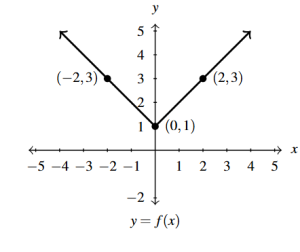
Answer to Exercise 19 - [latex]y = f(x) - 2[/latex]
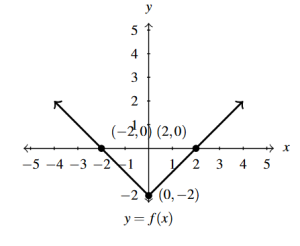
Answer to Exercise 20 - [latex]y = f(x+1)[/latex]
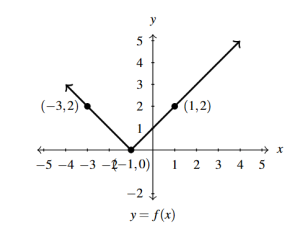
Answer to Exercise 21 - [latex]y = f(x - 2)[/latex]
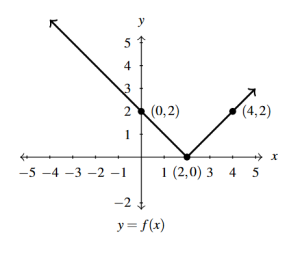
Answer to Exercise 22 - [latex]y = 2f(x)[/latex]
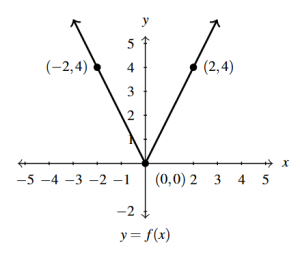
Answer to Exercise 23 - [latex]y = f(2x)[/latex]
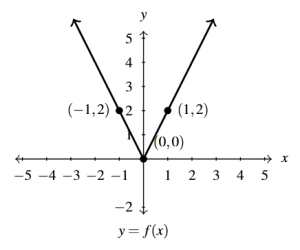
Answer to Exercise 24 - [latex]y = 2 - f(x)[/latex]

Answer to Exercise 25 - [latex]y = f(2-x)[/latex]
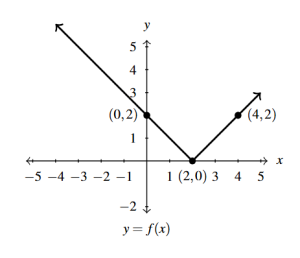
Answer to Exercise 26 - [latex]y = 2-f(2-x)[/latex]
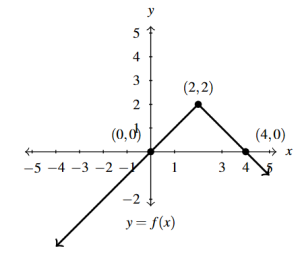
Answer to Exercise 27 - Answers left to Students
- Answers left to Students
- [latex]y = g(t) - 1[/latex]
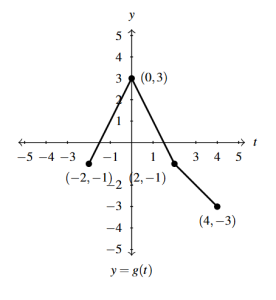
Answer to Exercise 30 - [latex]y = g(t + 1)[/latex]
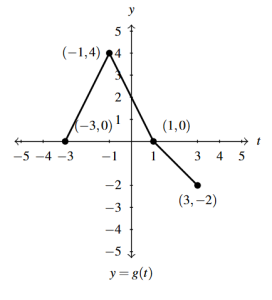
Answer to Exercise 31 - [latex]y = \frac{1}{2} g(t)[/latex]
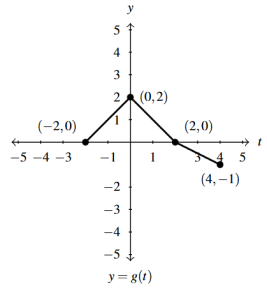
Answer to Exercise 32 - [latex]y =g(2t)[/latex]
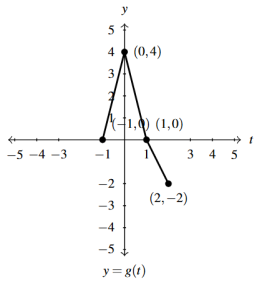
Answer to Exercise 33 - [latex]y = - g(t)[/latex]
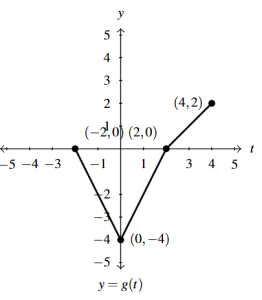
Answer to Exercise 34 - [latex]y = g(-t)[/latex]
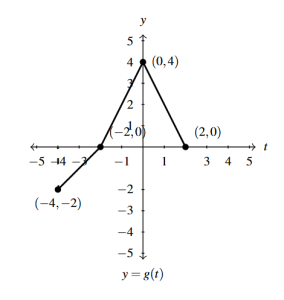
Answer to Exercise 35 - [latex]y = g(t+1) - 1[/latex]
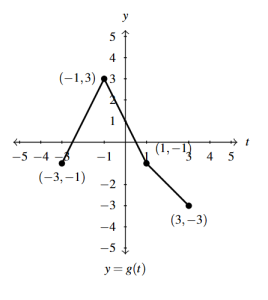
Answer to Exercise 36 - [latex]y = 1 -g(t)[/latex]
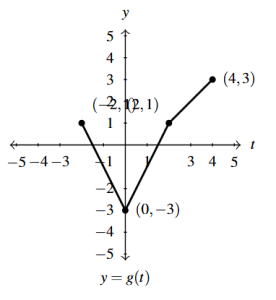
Answer to Exercise 37 - [latex]y = \frac{1}{2}g(t+1)-1[/latex]
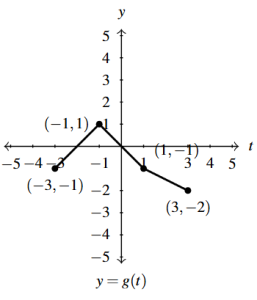
Answer to Exercise 38 - [latex]g(x) = f(x) + 3[/latex]
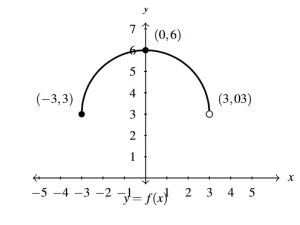
Answer to Exercise 39 - [latex]h(x) = f(x) - \frac{1}{2}[/latex]
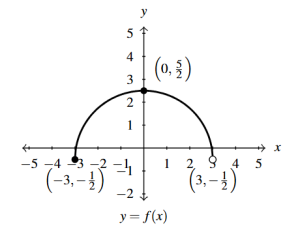
Answer to Exercise 40 - [latex]j(x) = f\left(x - \frac{2}{3}\right)[/latex]
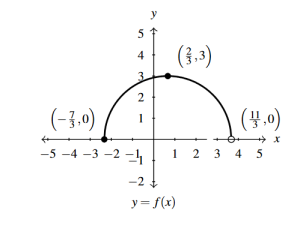
Answer to Exercise 41 - [latex]a(x) = f(x + 4)[/latex]
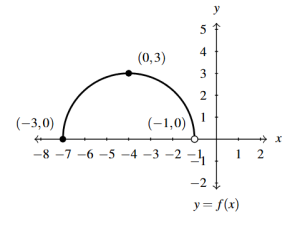
Answer to Exercise 42 - [latex]b(x) = f(x + 1) - 1[/latex]
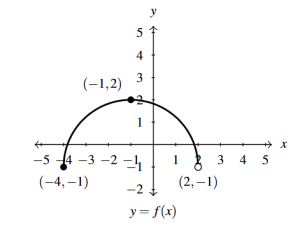
Answer to Exercise 43 - [latex]c(x) = \frac{3}{5}f(x)[/latex]
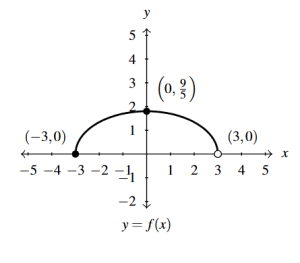
Answer to Exercise 44 - [latex]d(x) = -2f(x)[/latex]
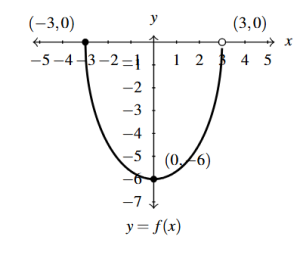
Answer to Exercise 45 - [latex]k(x) = f\left(\frac{2}{3}x\right)[/latex]
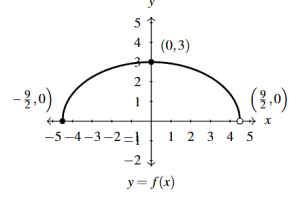
Answer to Exercise 46 - [latex]m(x) = -\frac{1}{4}f(3x)[/latex]
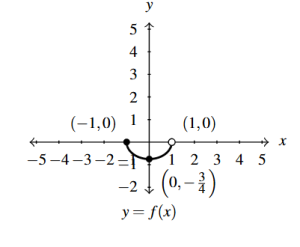
Answer to Exercise 47 - [latex]n(x) = 4f(x - 3) - 6[/latex]
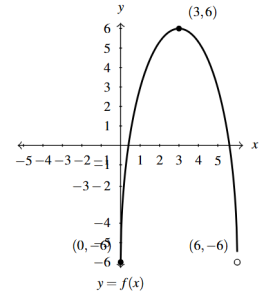
Answer to Exercise 48 - [latex]p(x) = 4 + f(1 - 2x) = f(-2x + 1) + 4[/latex]
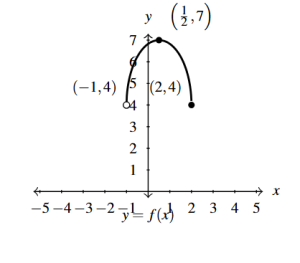
Answer to Exercise 49 - [latex]q(x) = -\frac{1}{2}f\left(\frac{x + 4}{2}\right) - 3 = -\frac{1}{2}f\left( \frac{1}{2}x + 2 \right) - 3[/latex]
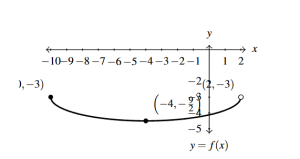
Answer to Exercise 50 - [latex]y = S_{\text{\tiny 1}}(t) = S(t + 1)[/latex]
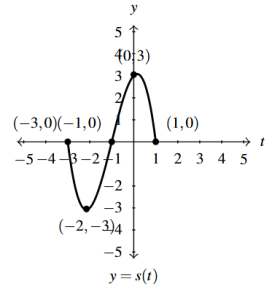
Answer to Exercise 51 - [latex]y = S_{\text{\tiny 2}}(t) = S_{\text{\tiny 1}}(-t) = S(-t + 1)[/latex]
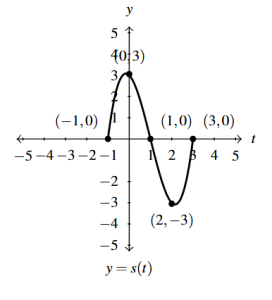
Answer to Exercise 52 - [latex]y = S_{\text{\tiny 3}}(t) = \frac{1}{2} S_{\text{\tiny 2}}(t) = \frac{1}{2}S(-t+1)[/latex]
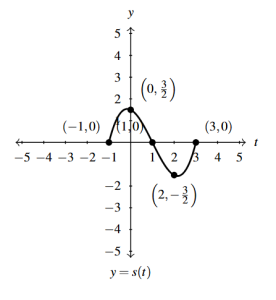
Answer to Exercise 53 - [latex]y = S_{\text{\tiny 4}}(t) = S_{\text{\tiny 3}}(t) + 1 = \frac{1}{2}S(-t+1) + 1[/latex]
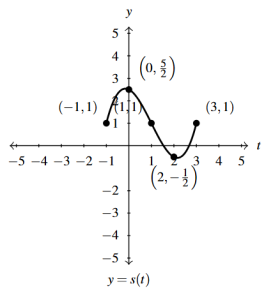
Answer to Exercise 54 -
[latex]g(x) = \sqrt{x-2} - 3[/latex]
-
[latex]g(x) = \sqrt{x-2} - 3[/latex]
-
[latex]g(x) = -\sqrt{x} + 1[/latex]
-
[latex]g(x) = -(\sqrt{x} + 1) = -\sqrt{x} - 1[/latex]
-
[latex]g(x) = \sqrt{-x+1} + 2[/latex]
-
[latex]g(x) = \sqrt{-(x+1)} + 2 = \sqrt{-x-1} + 2[/latex]
-
[latex]g(x) = 2\sqrt{x+3} - 4[/latex]
-
[latex]g(x) = 2\left(\sqrt{x+3} - 4\right) = 2\sqrt{x+3} - 8[/latex]
-
[latex]g(x) = \sqrt{2x-3} + 1[/latex]
-
[latex]g(x) = \sqrt{2(x-3)} + 1 = \sqrt{2x-6}+1[/latex]
-
[latex]g(x)=f(x)+1[/latex]
-
[latex]h(x) = f(x-2)[/latex]
-
[latex]p(x) = f\left( \frac{x}{2} \right) -1[/latex]
-
[latex]q(x) = -2f(x) = 2f(-x)[/latex]
-
[latex]r(x) = 2f(x+1)-3[/latex]
-
[latex]s(x) = 2f(-x+1)-3 = -2f(x-1)+3[/latex]
-
[latex]g(x) = -2\sqrt[3]{x + 3} - 1[/latex] or [latex]g(x) = 2\sqrt[3]{-x - 3} - 1[/latex]
- Answers May Vary
- Answers May Vary
- Answers May Vary
- Answers May Vary
- Answers May Vary
- This is called the fixed or start-up cost. We'll revisit this concept in Example 1.3.8 in Section 1.3.1. ↵

